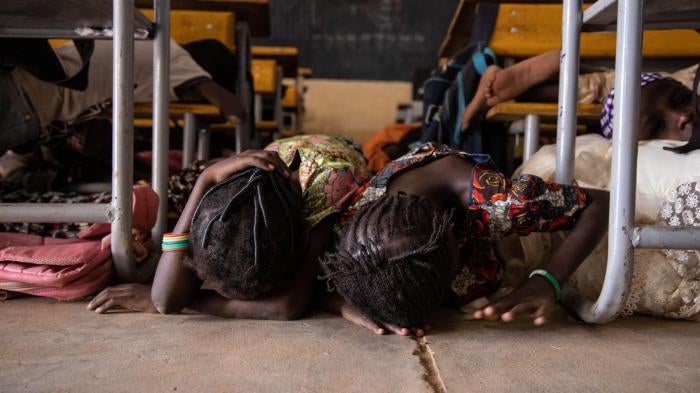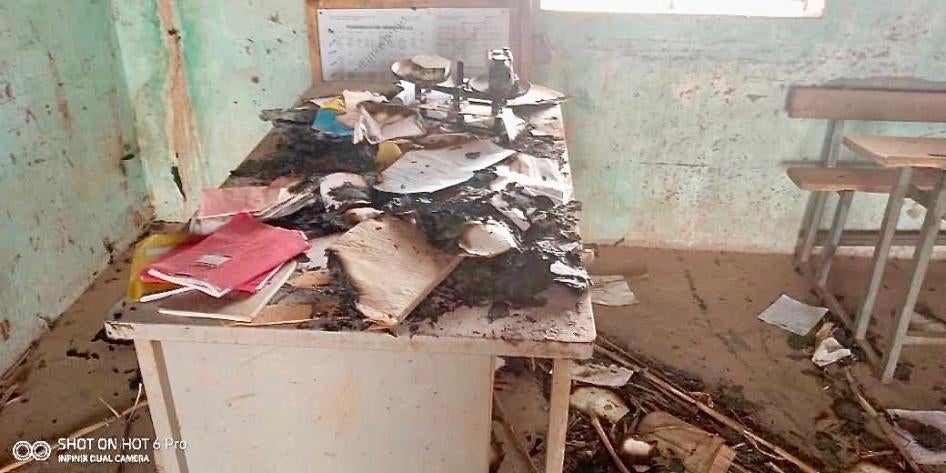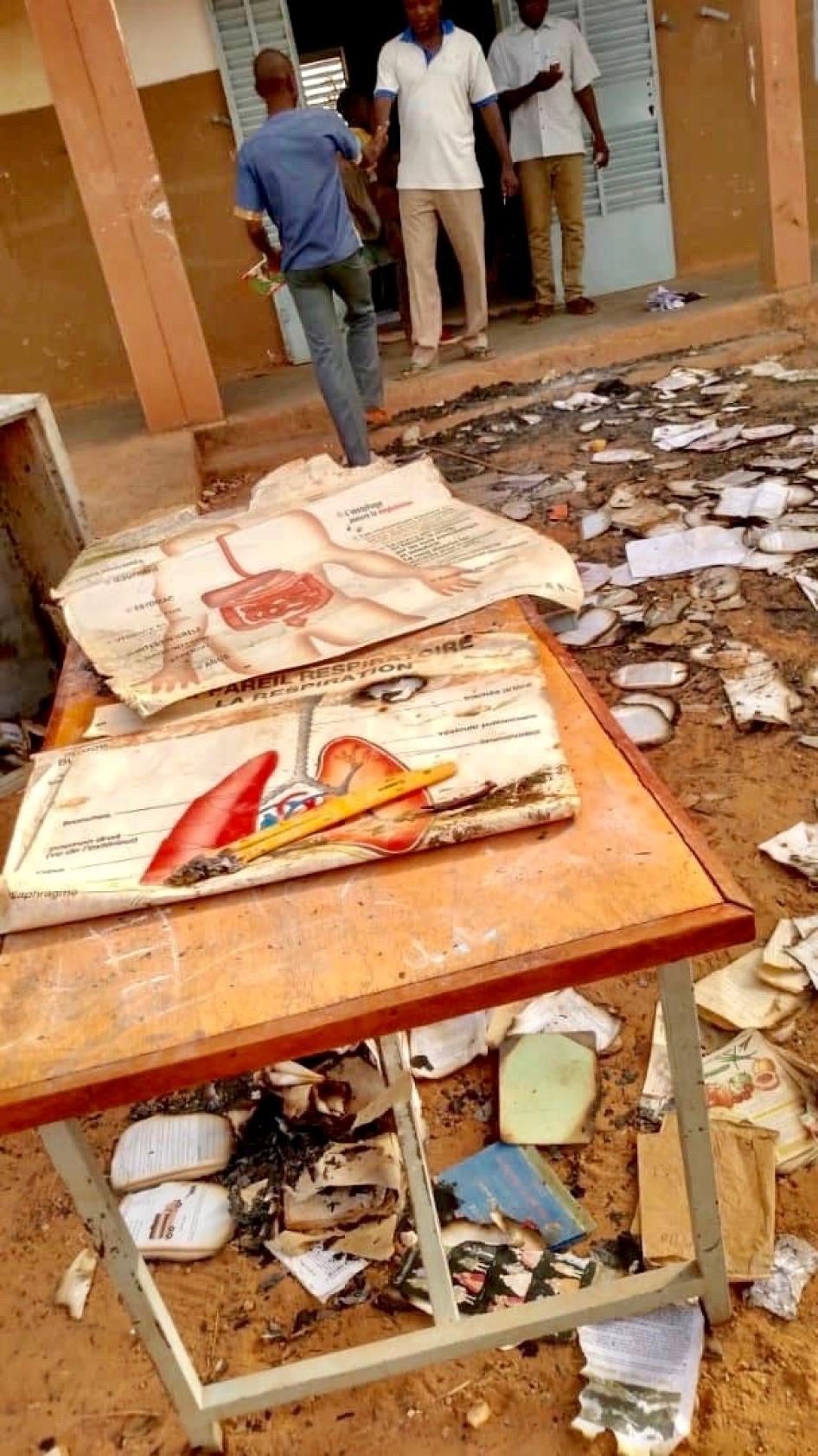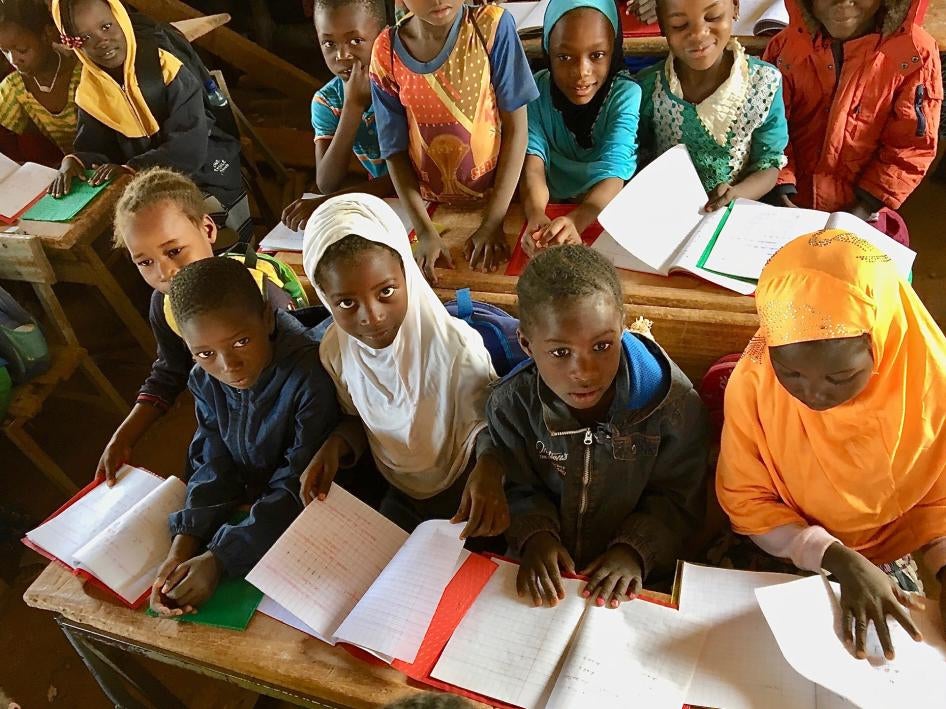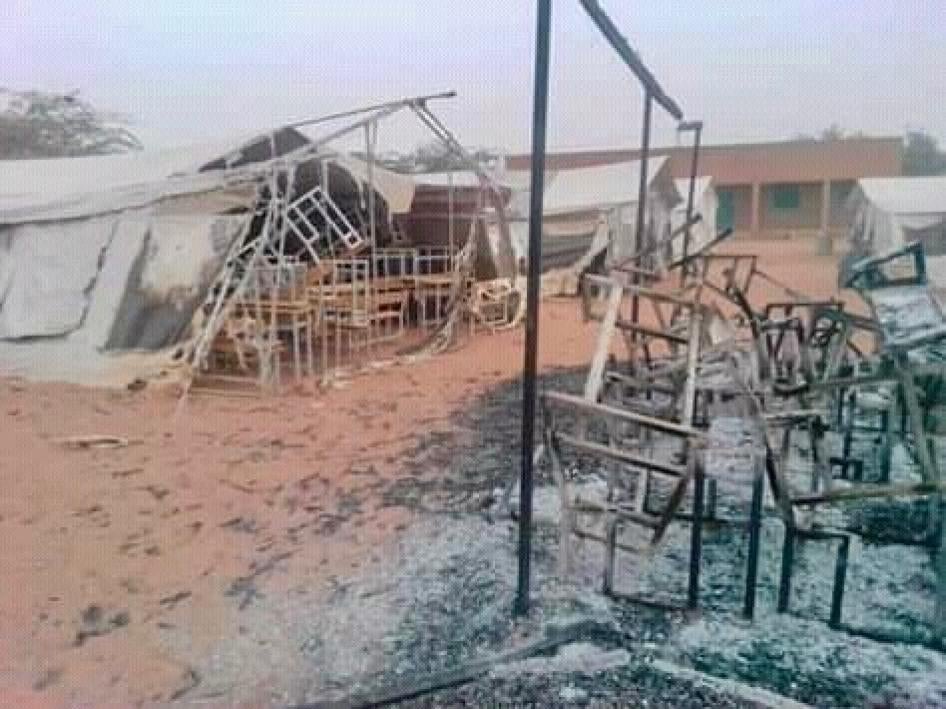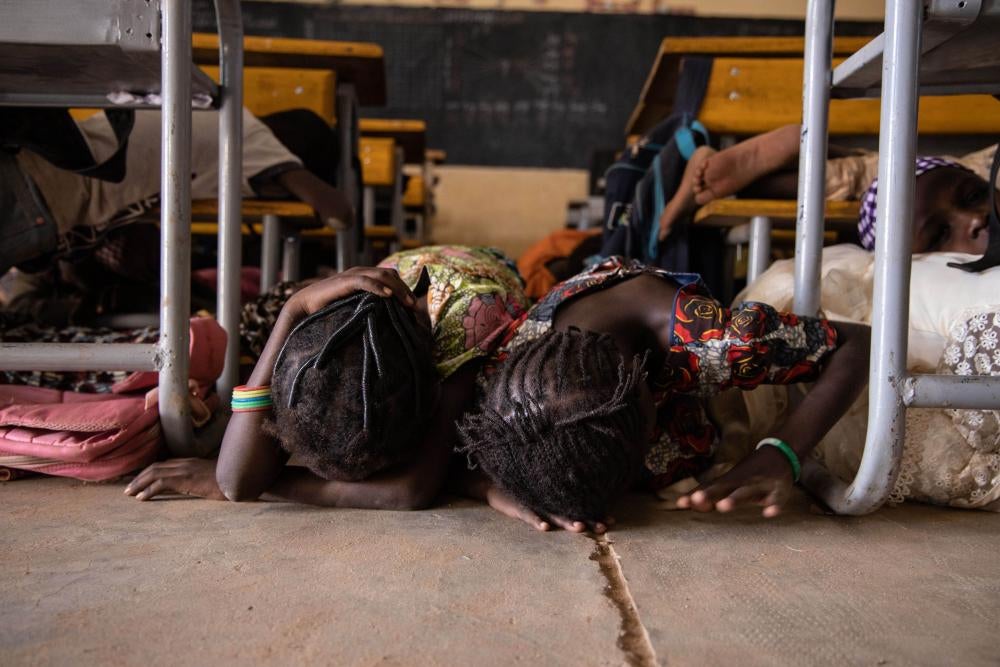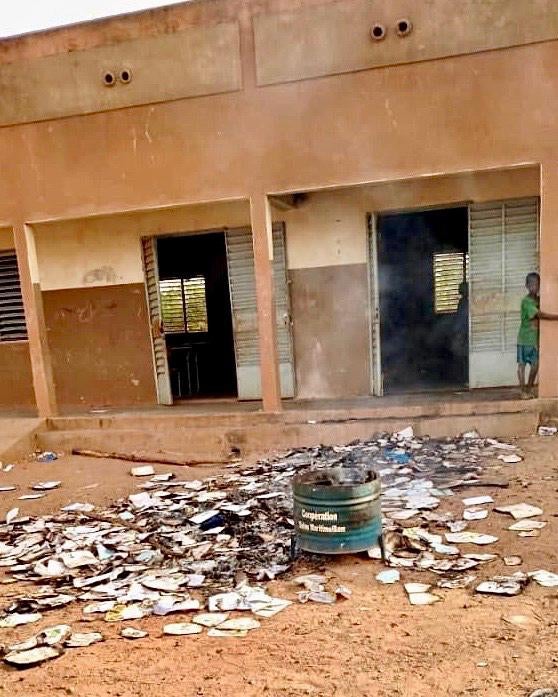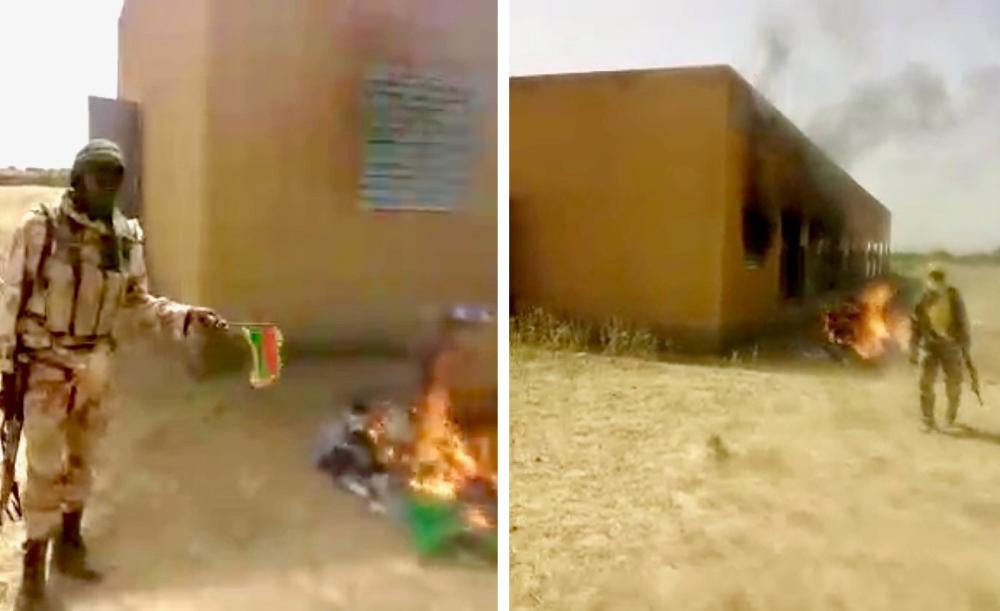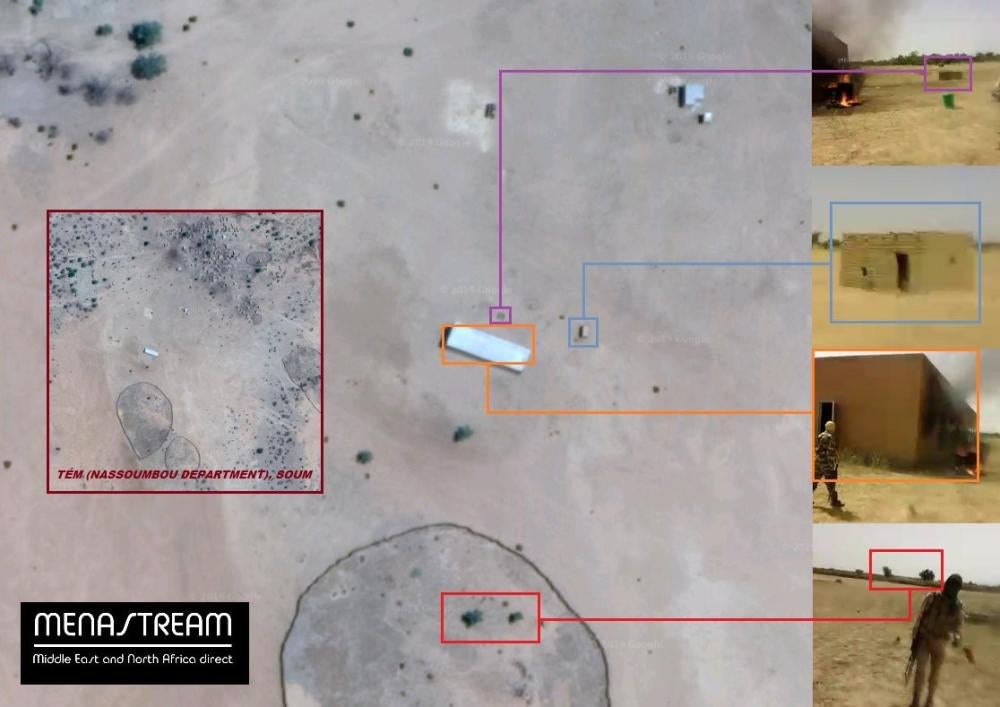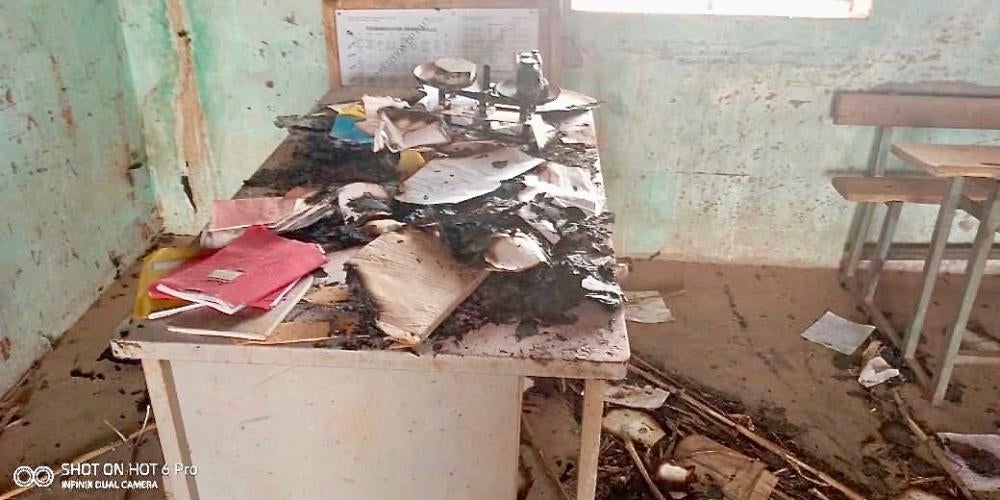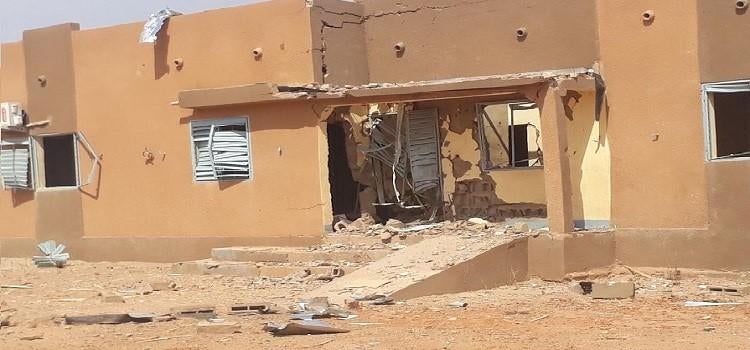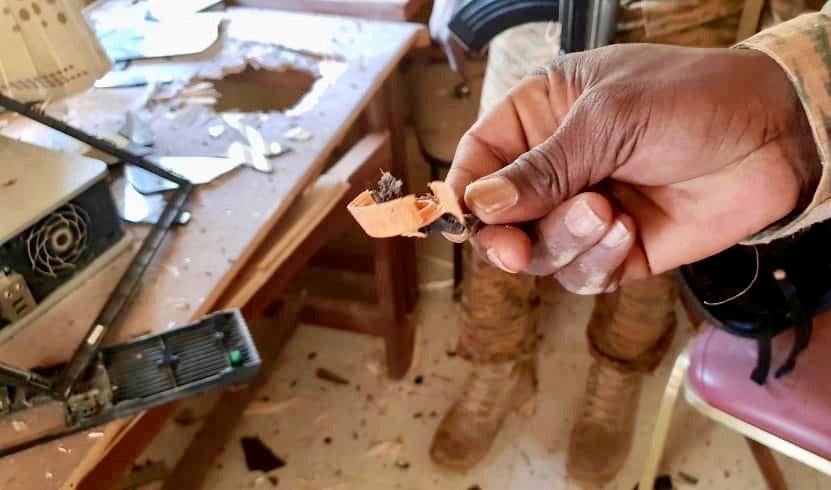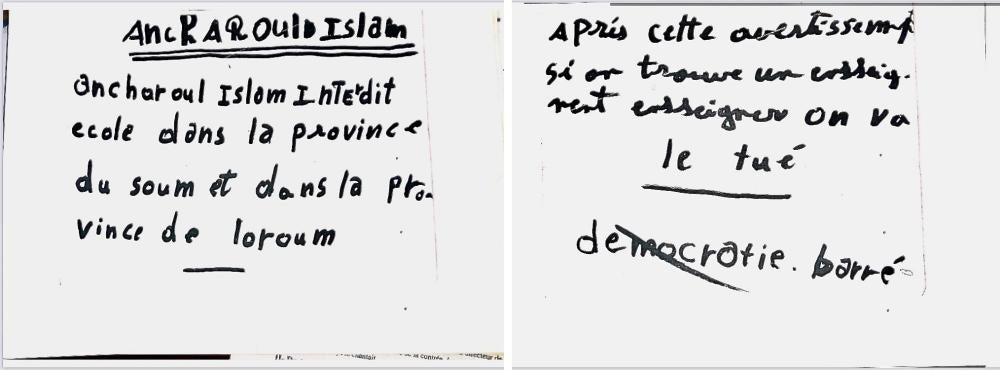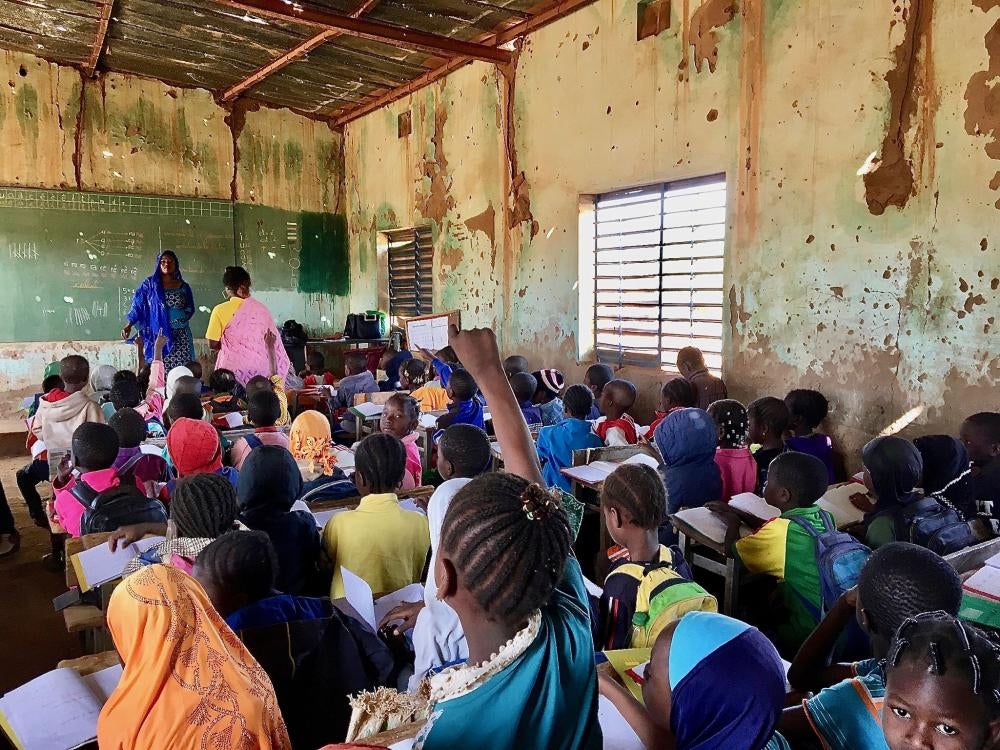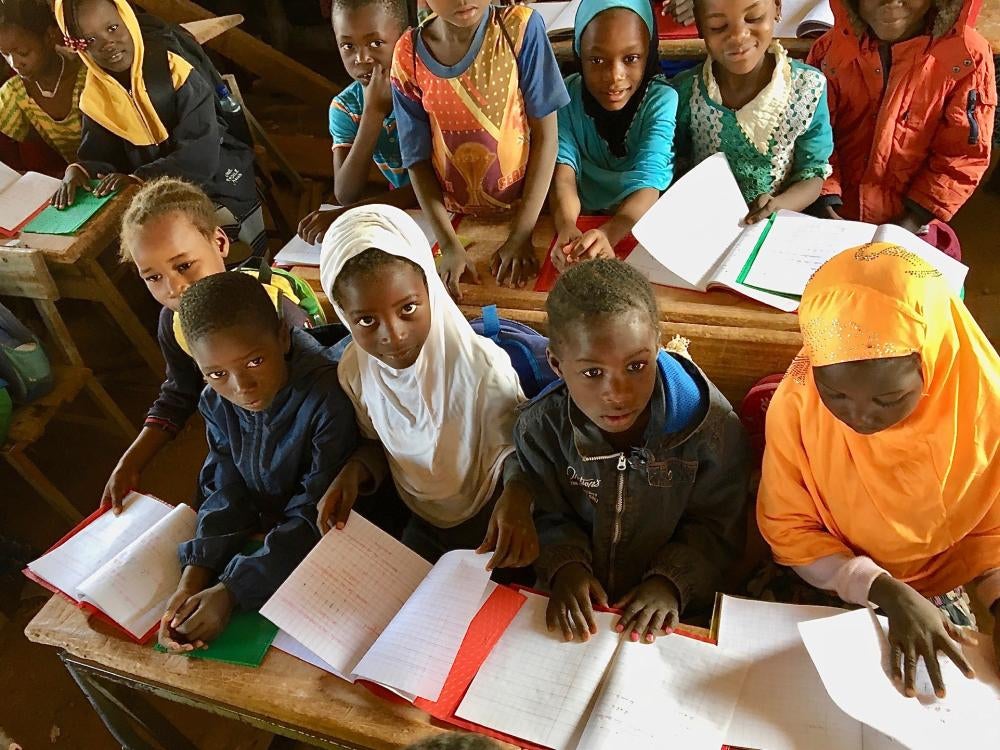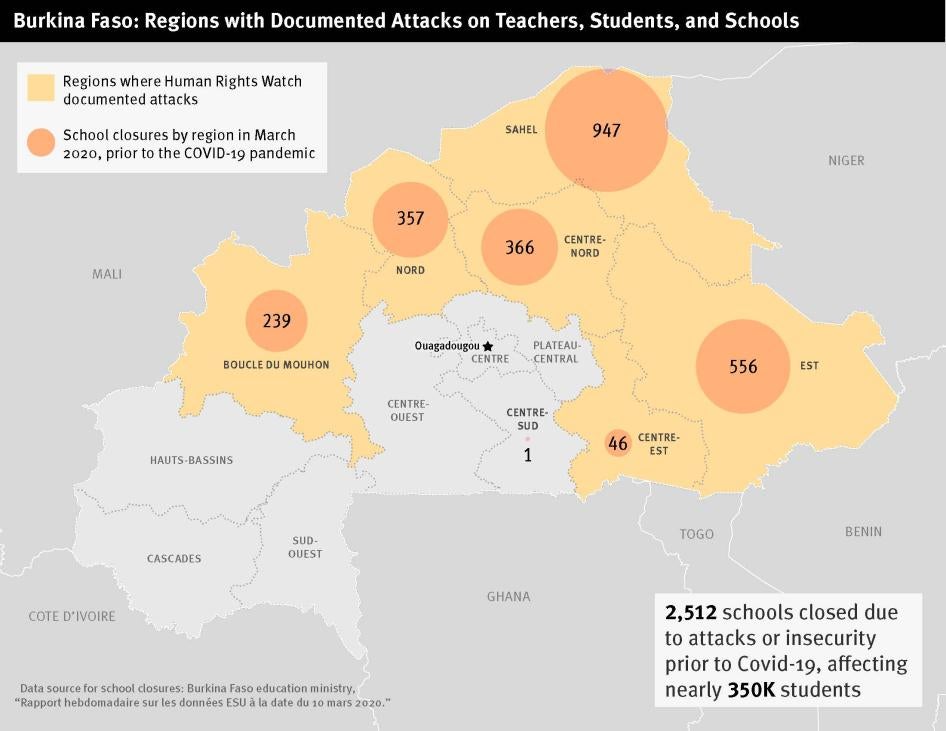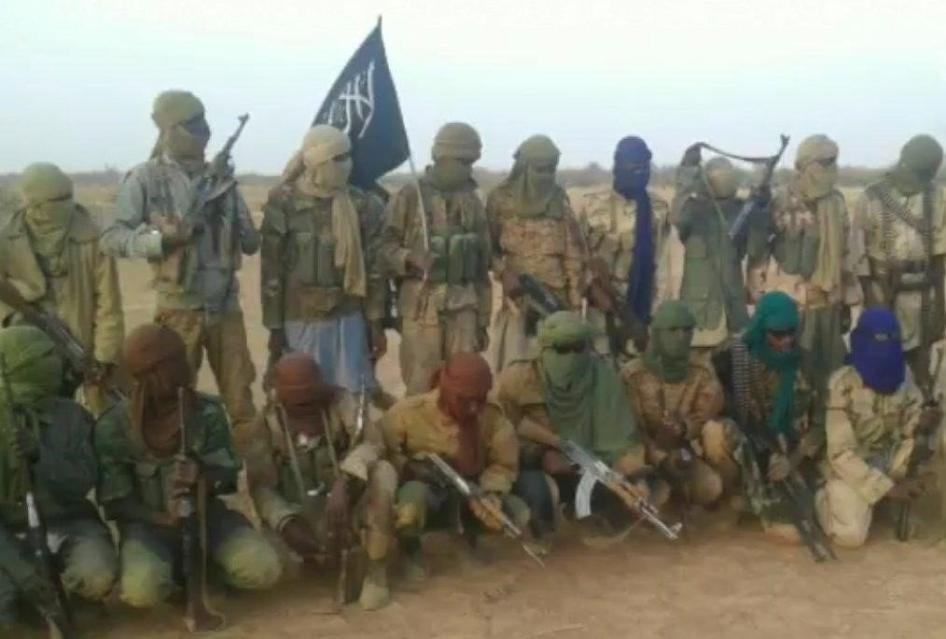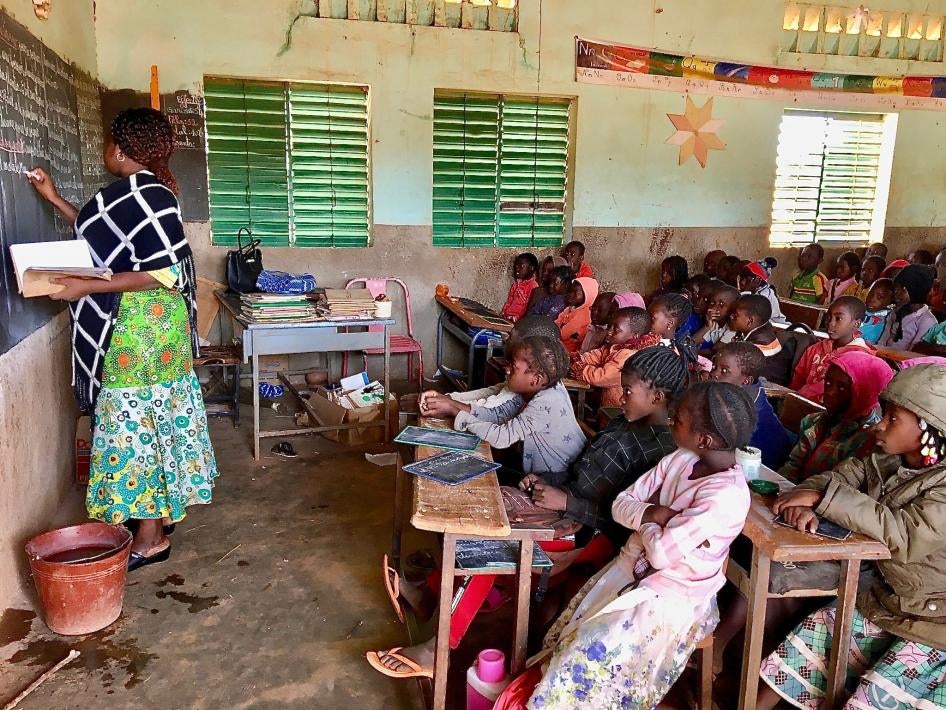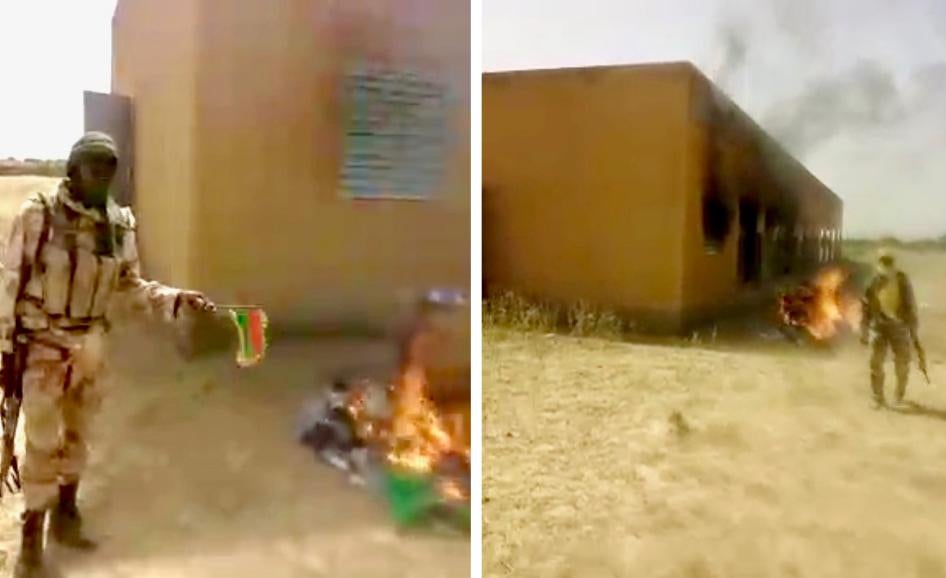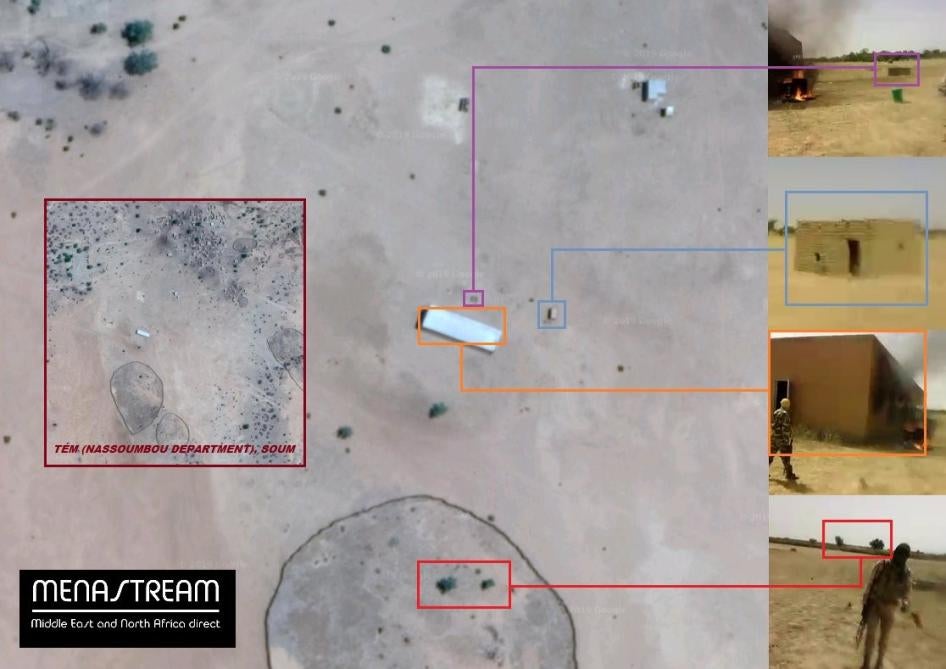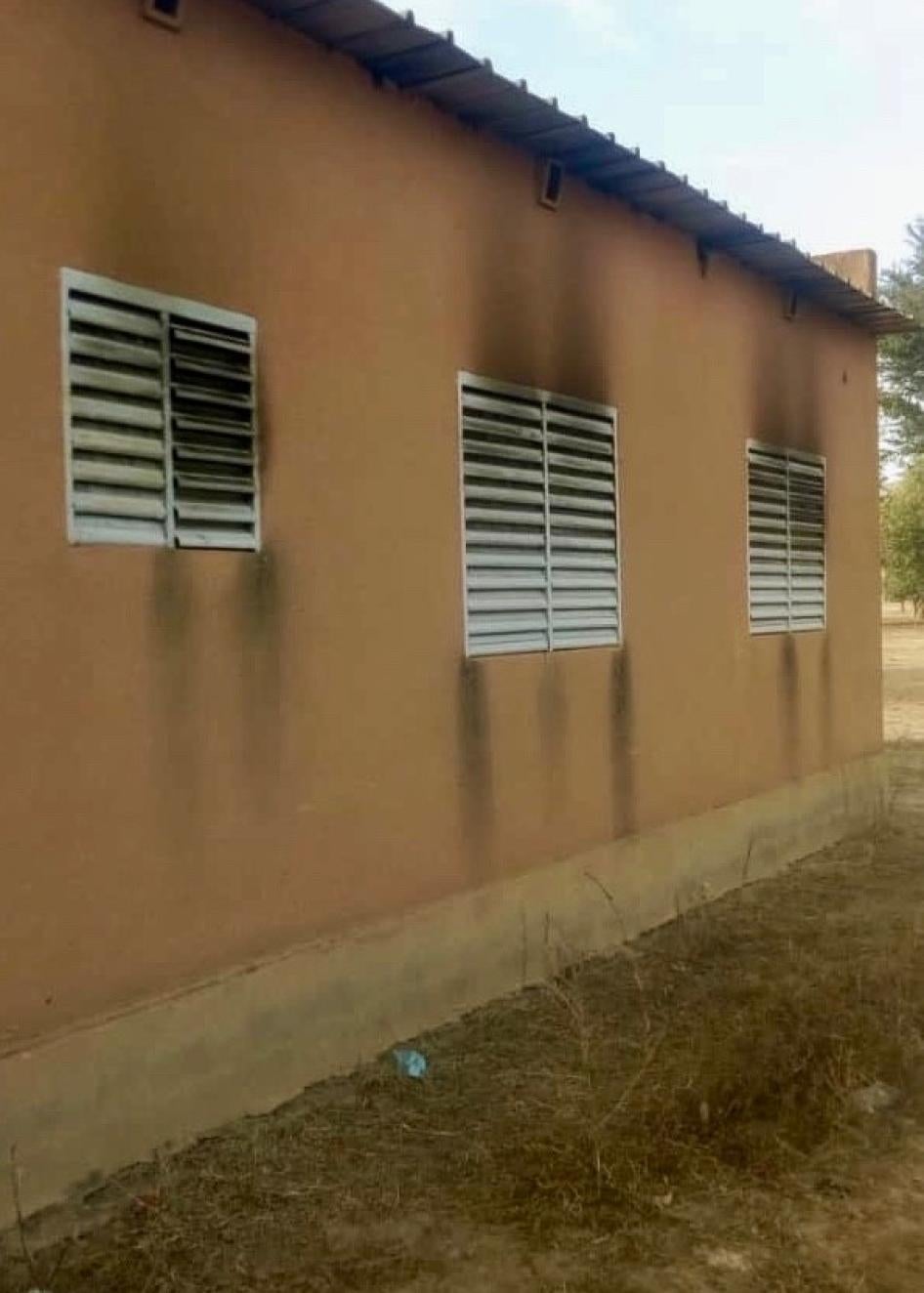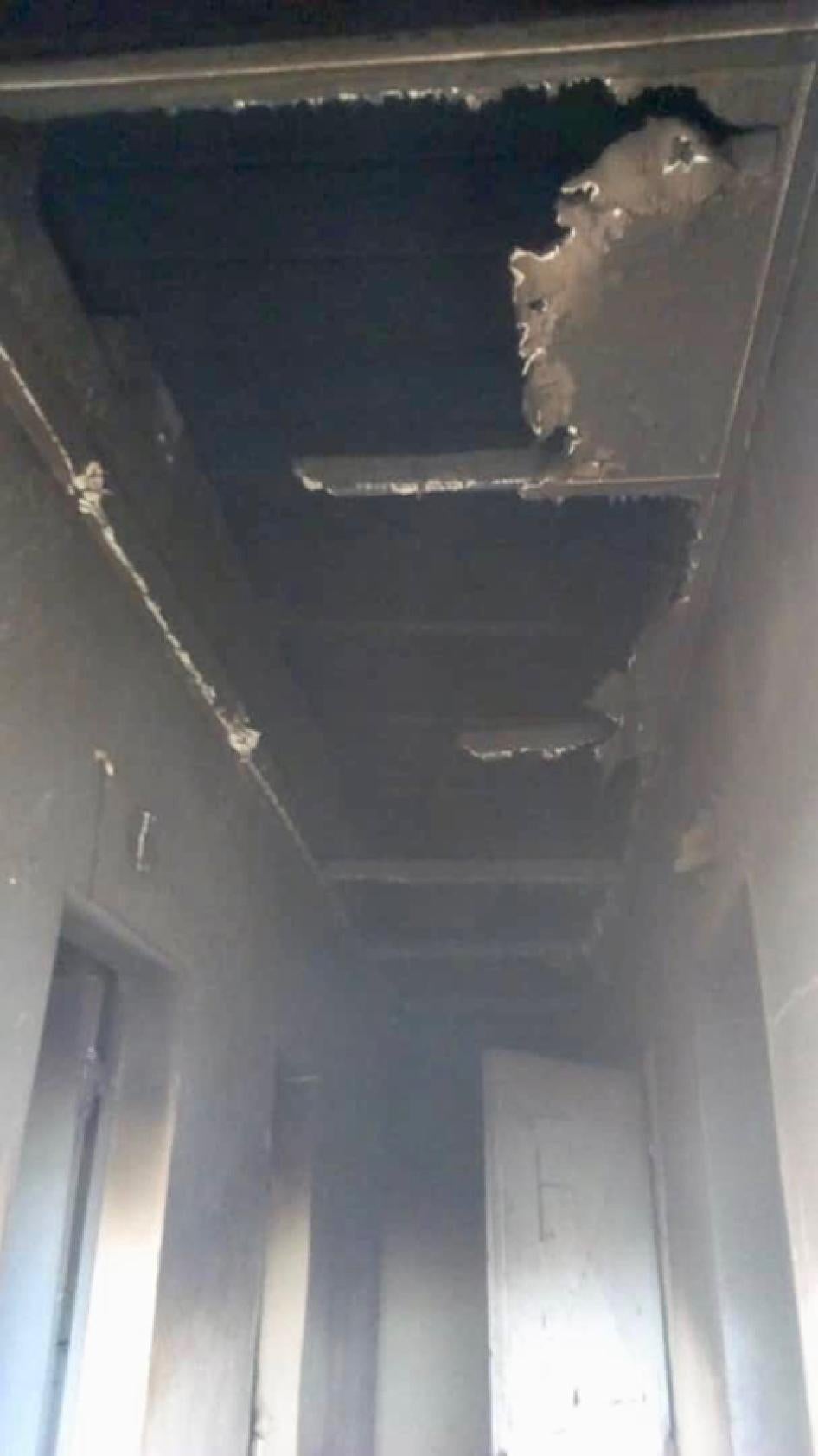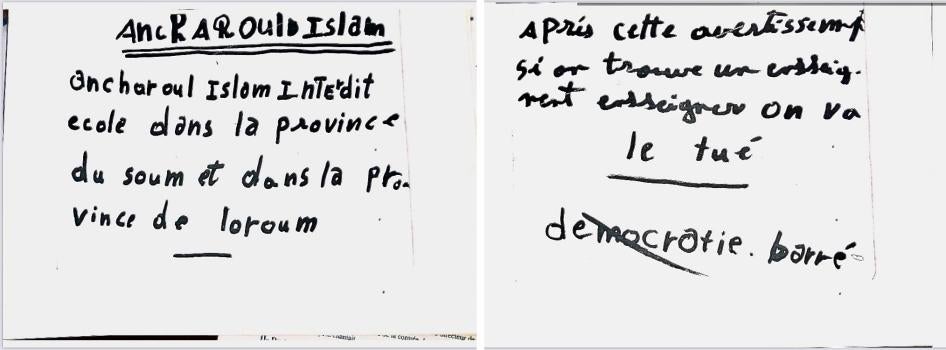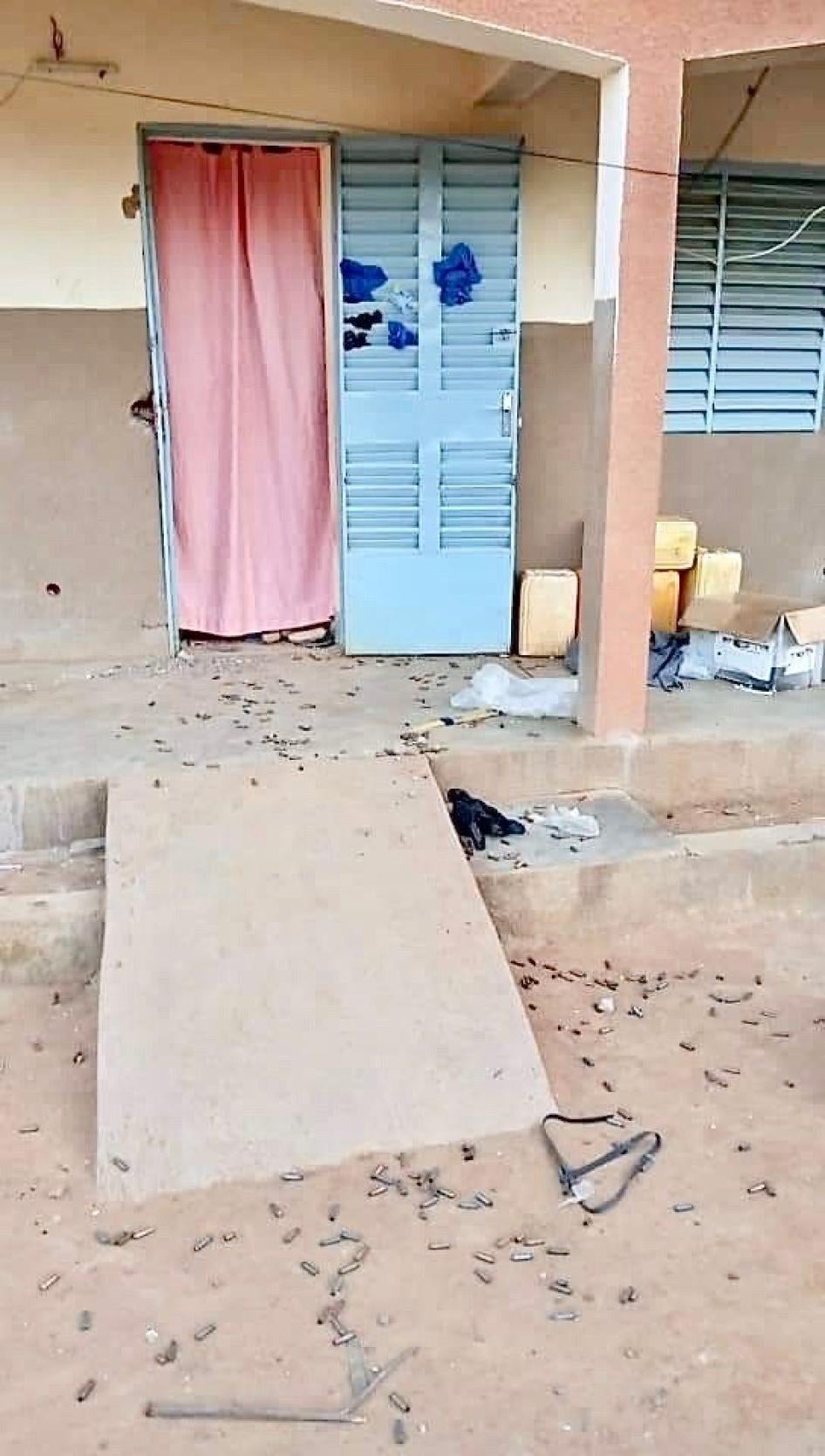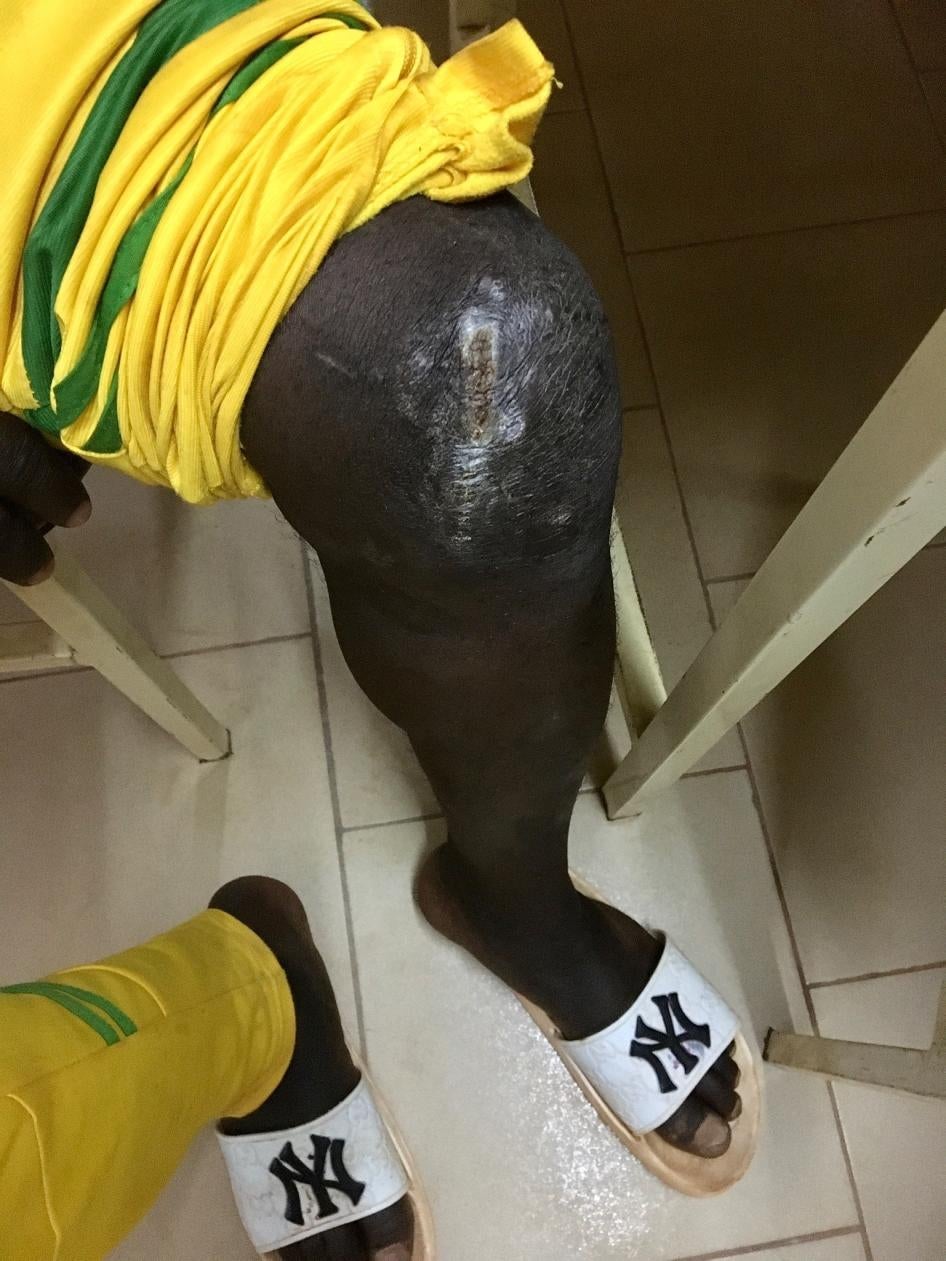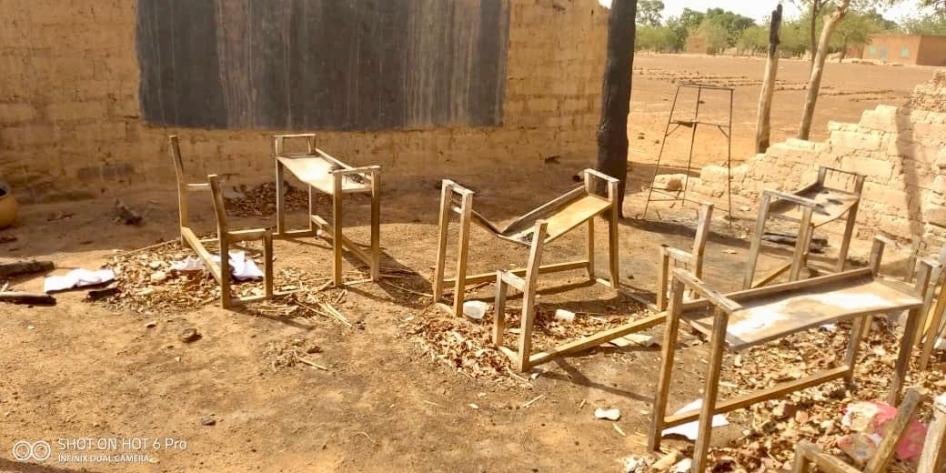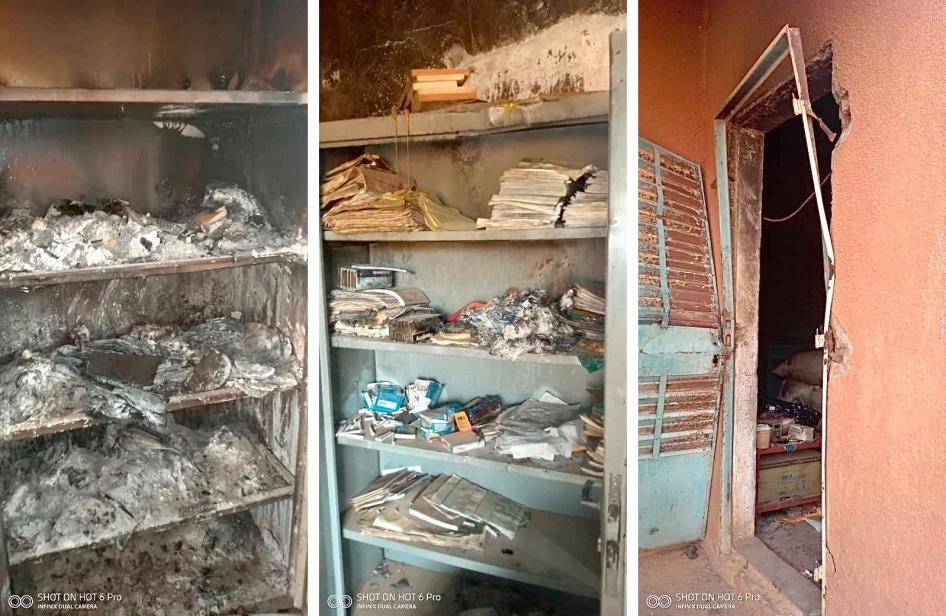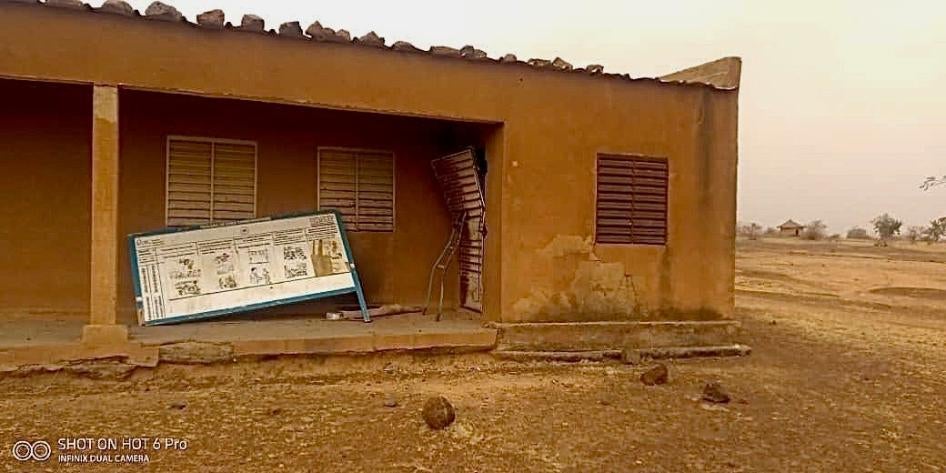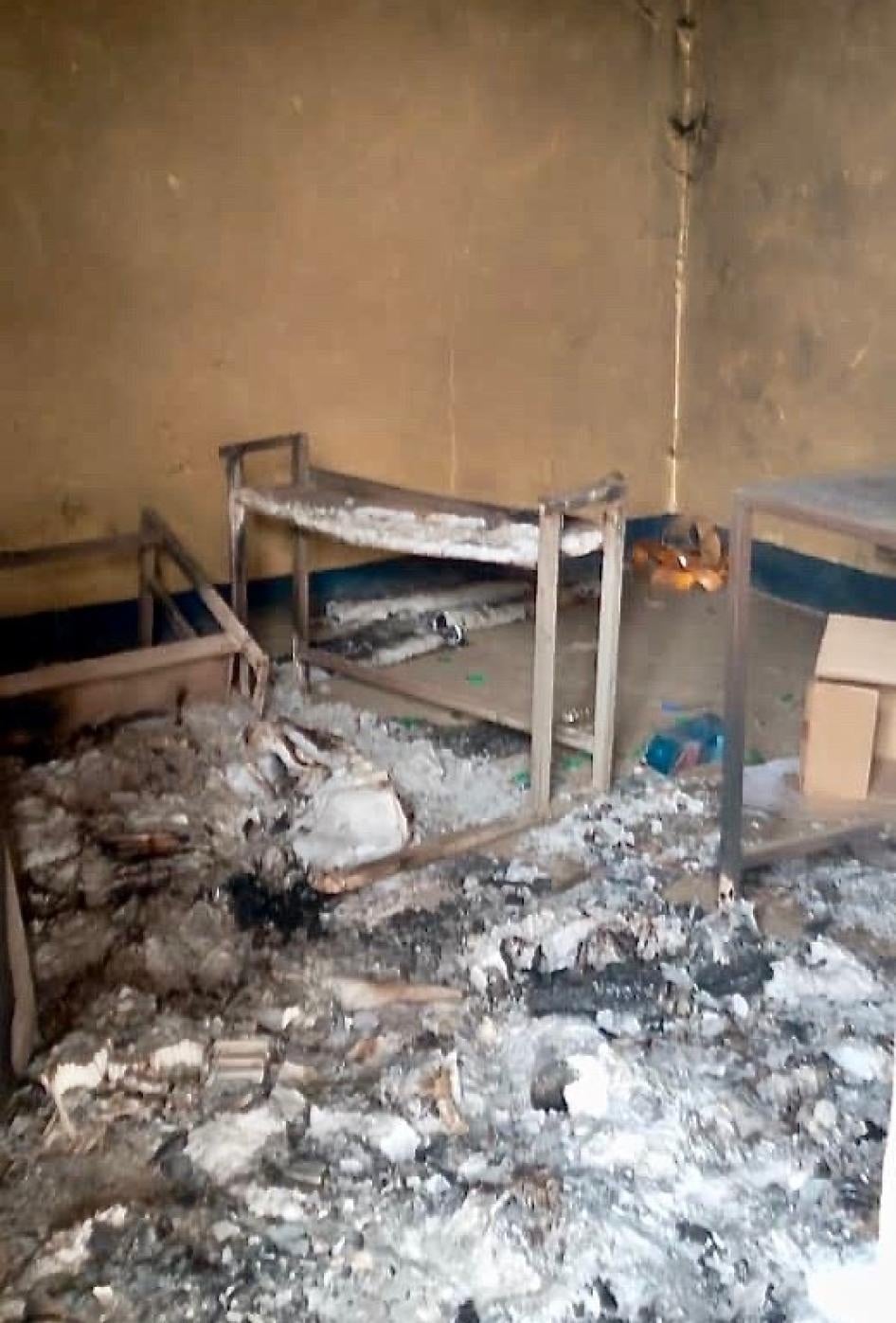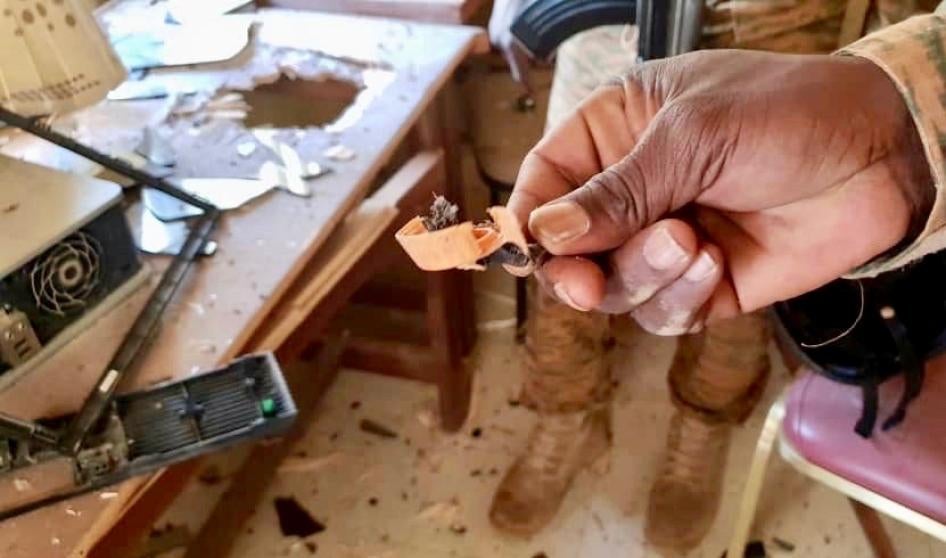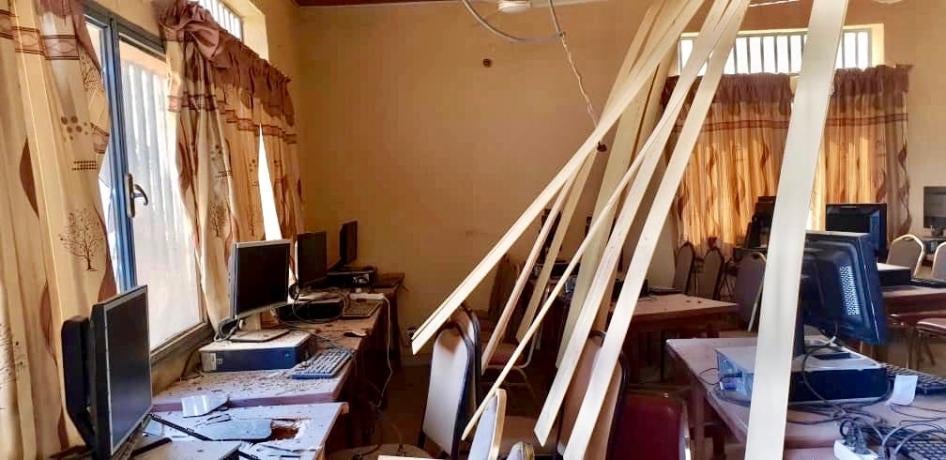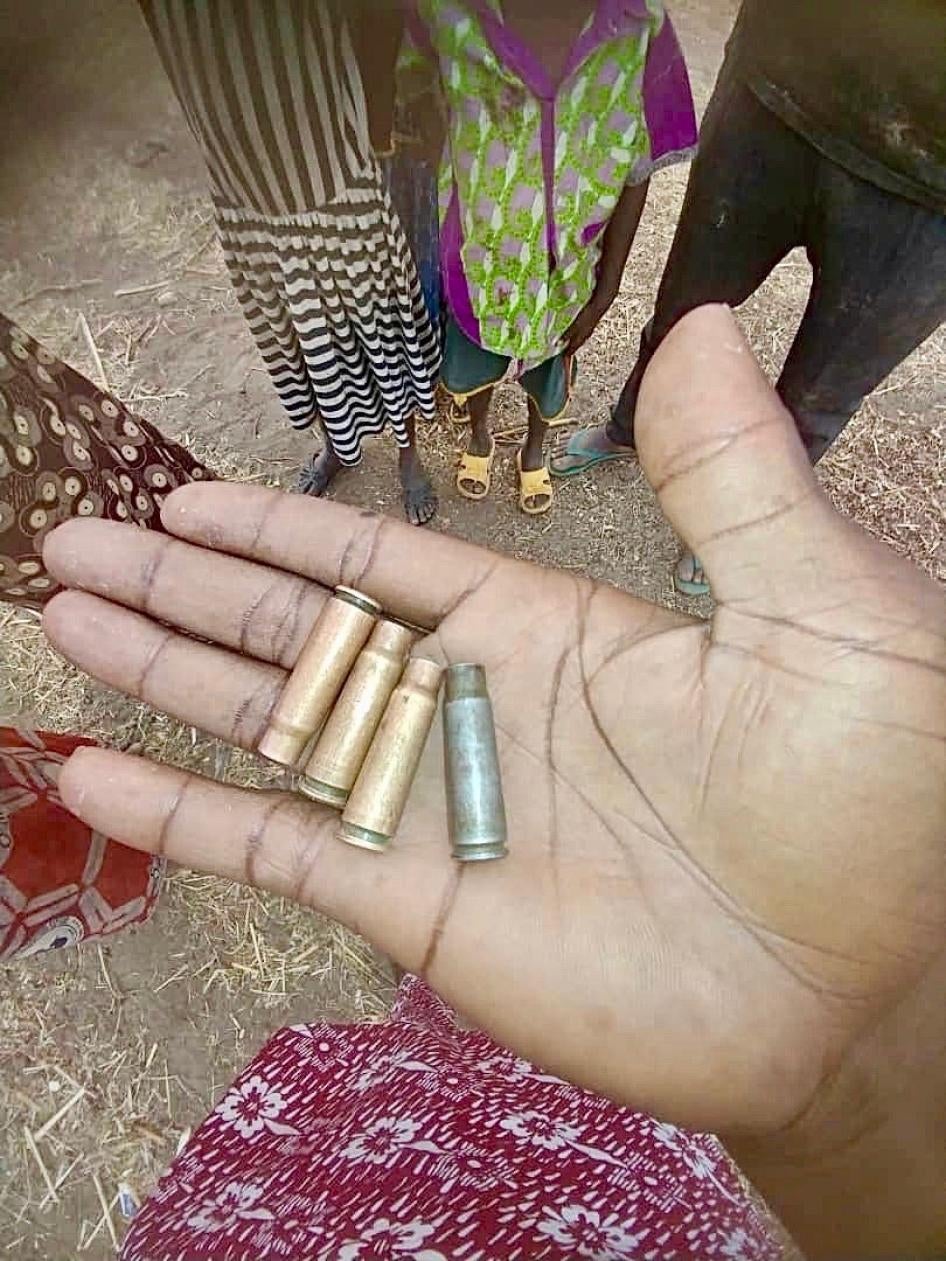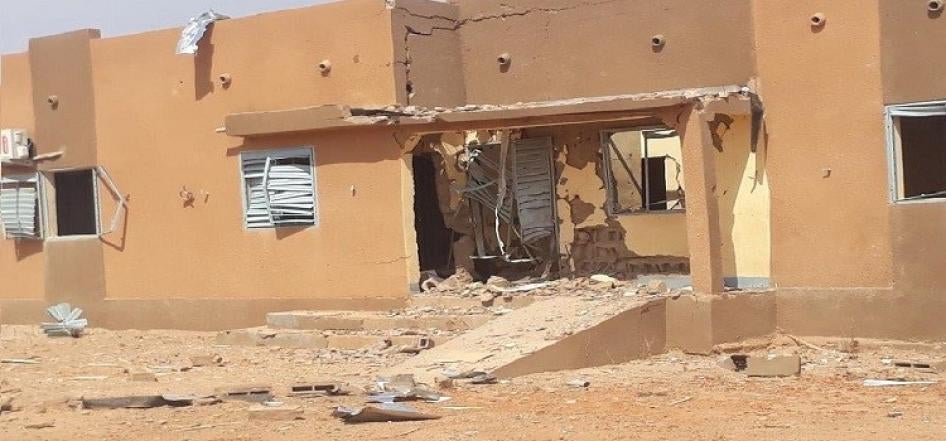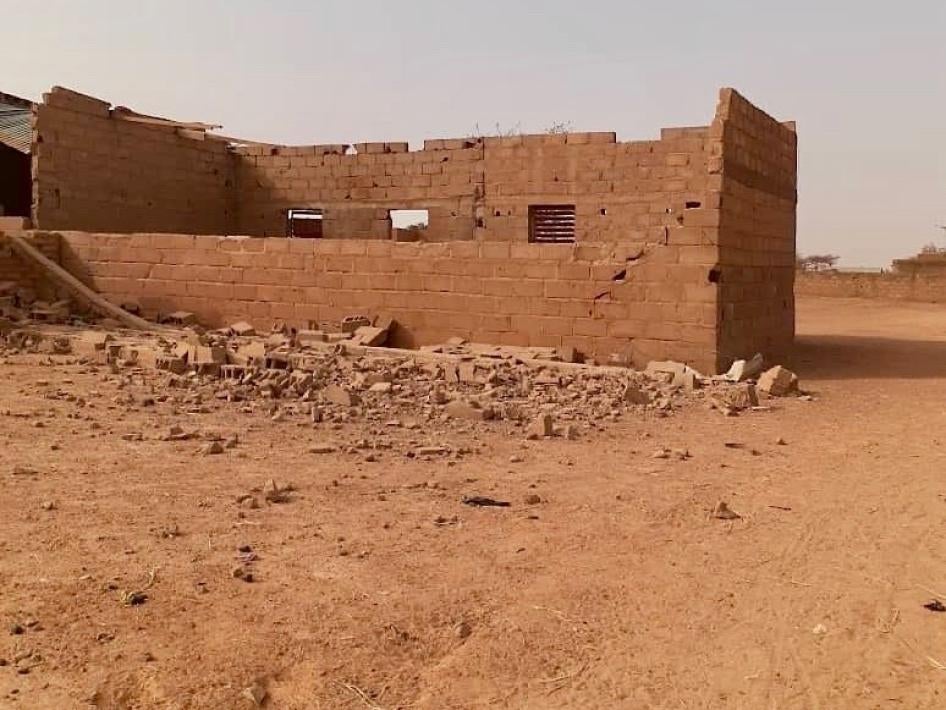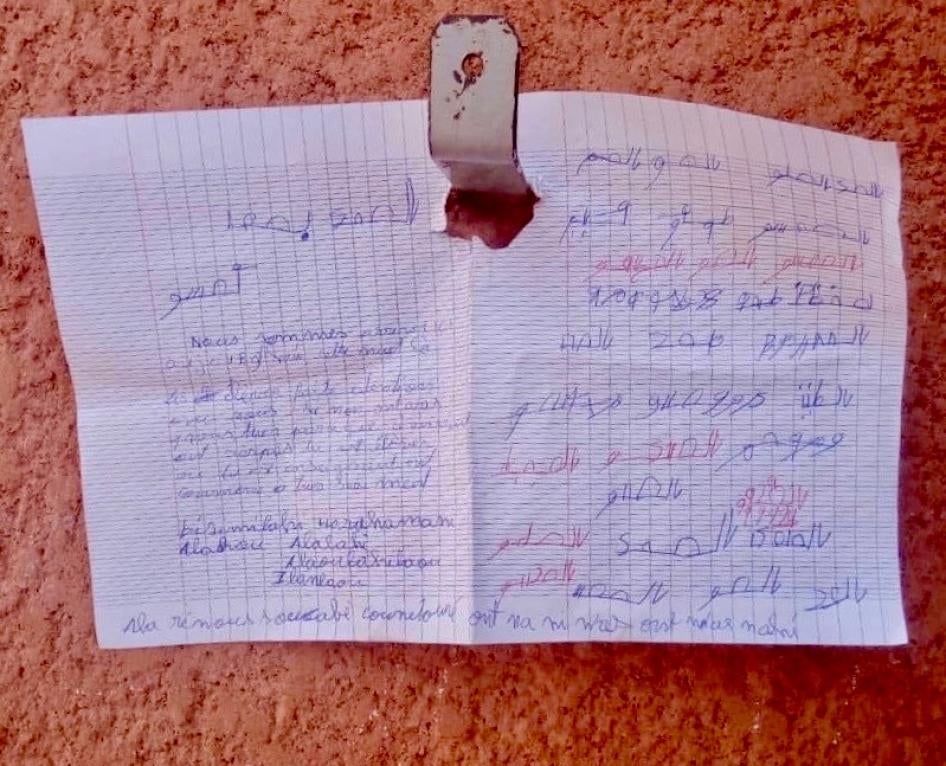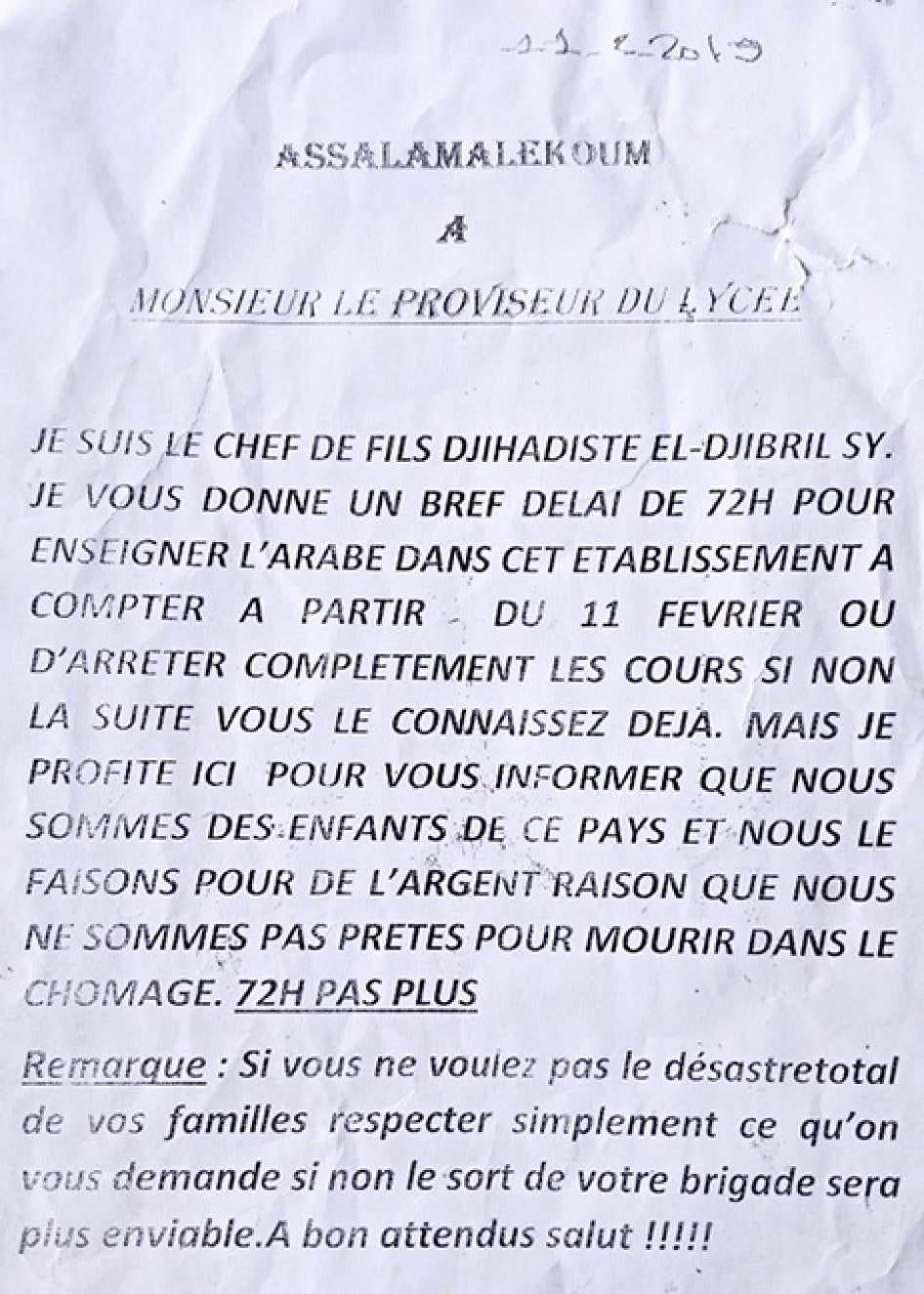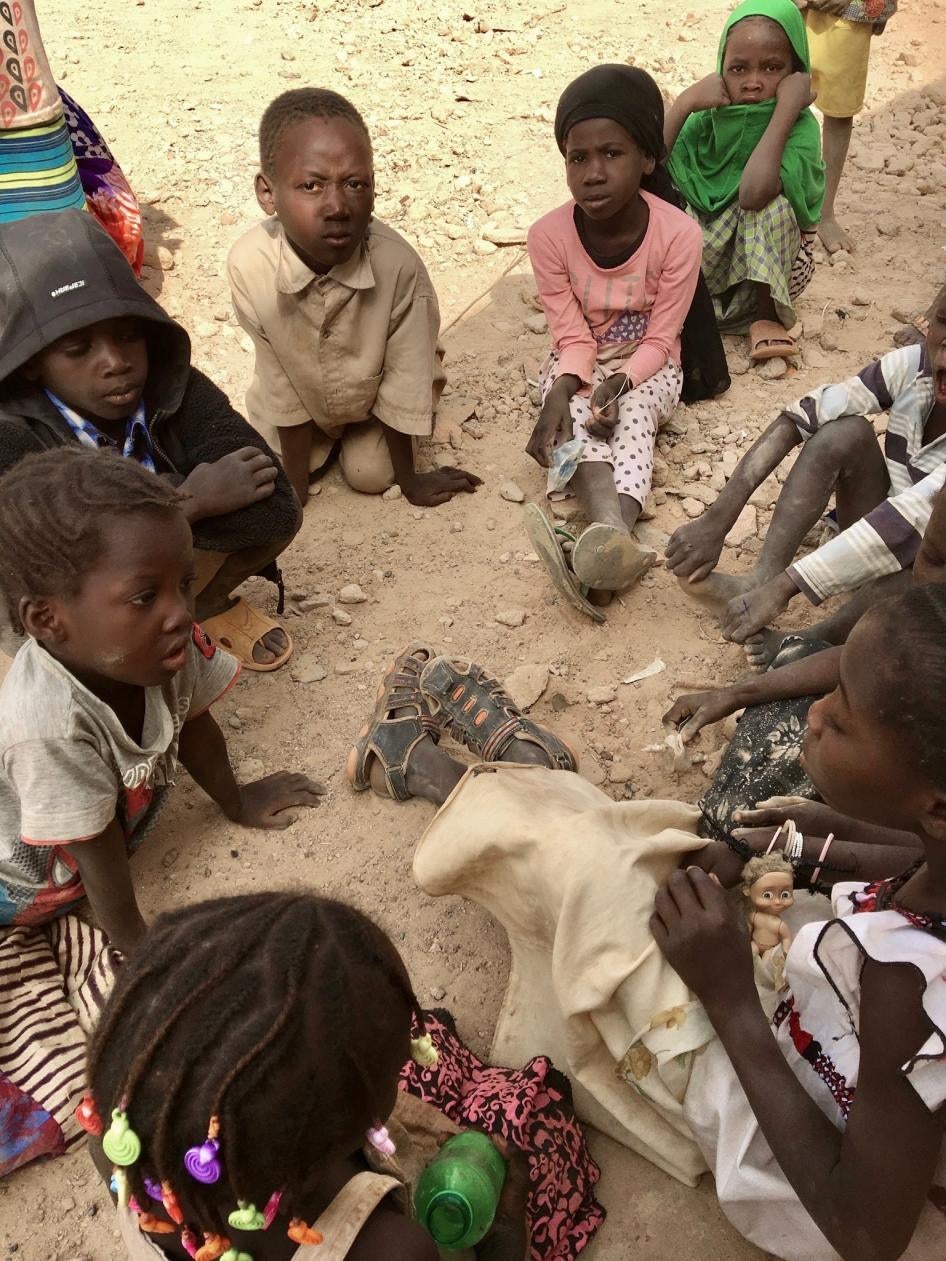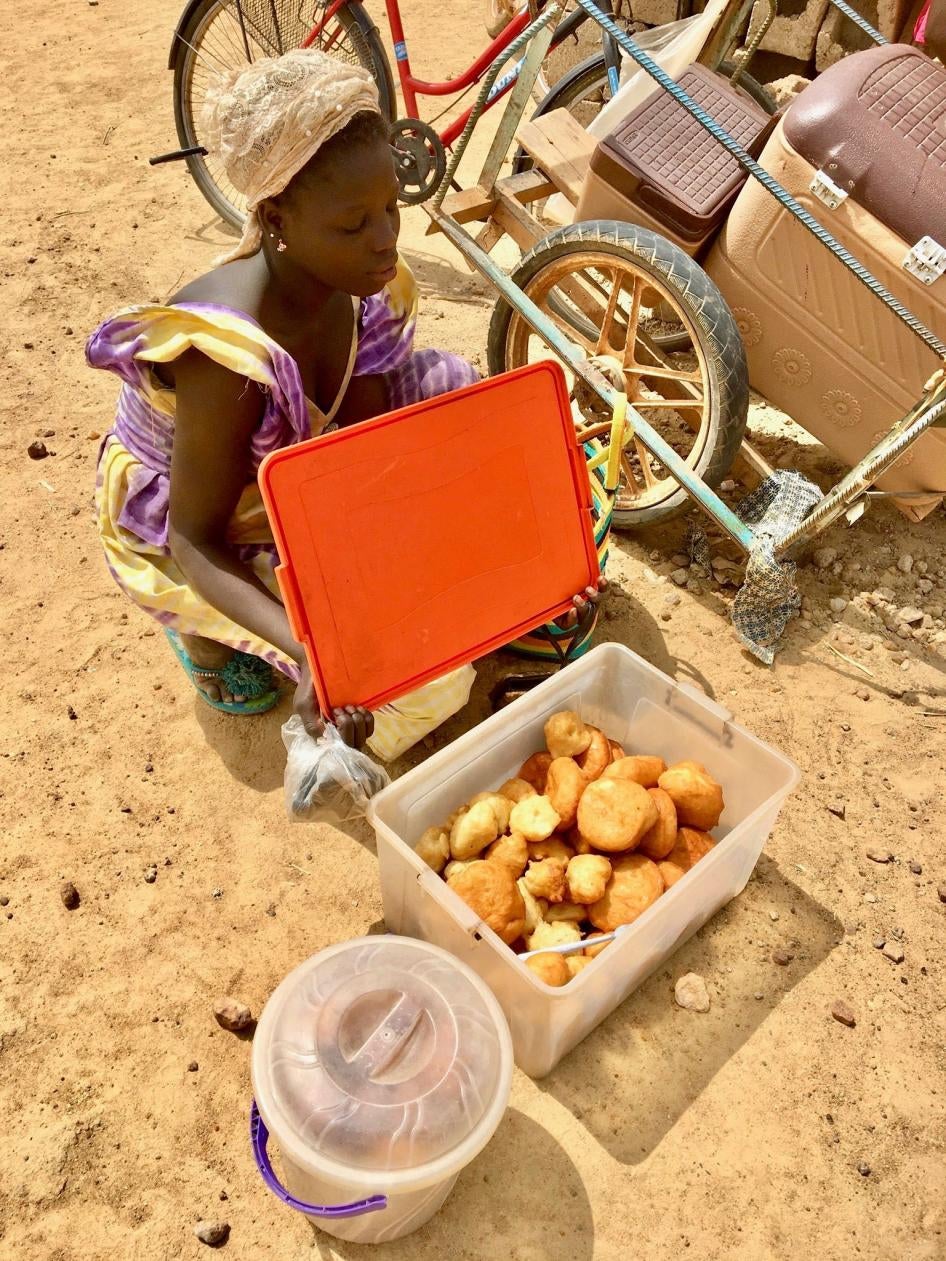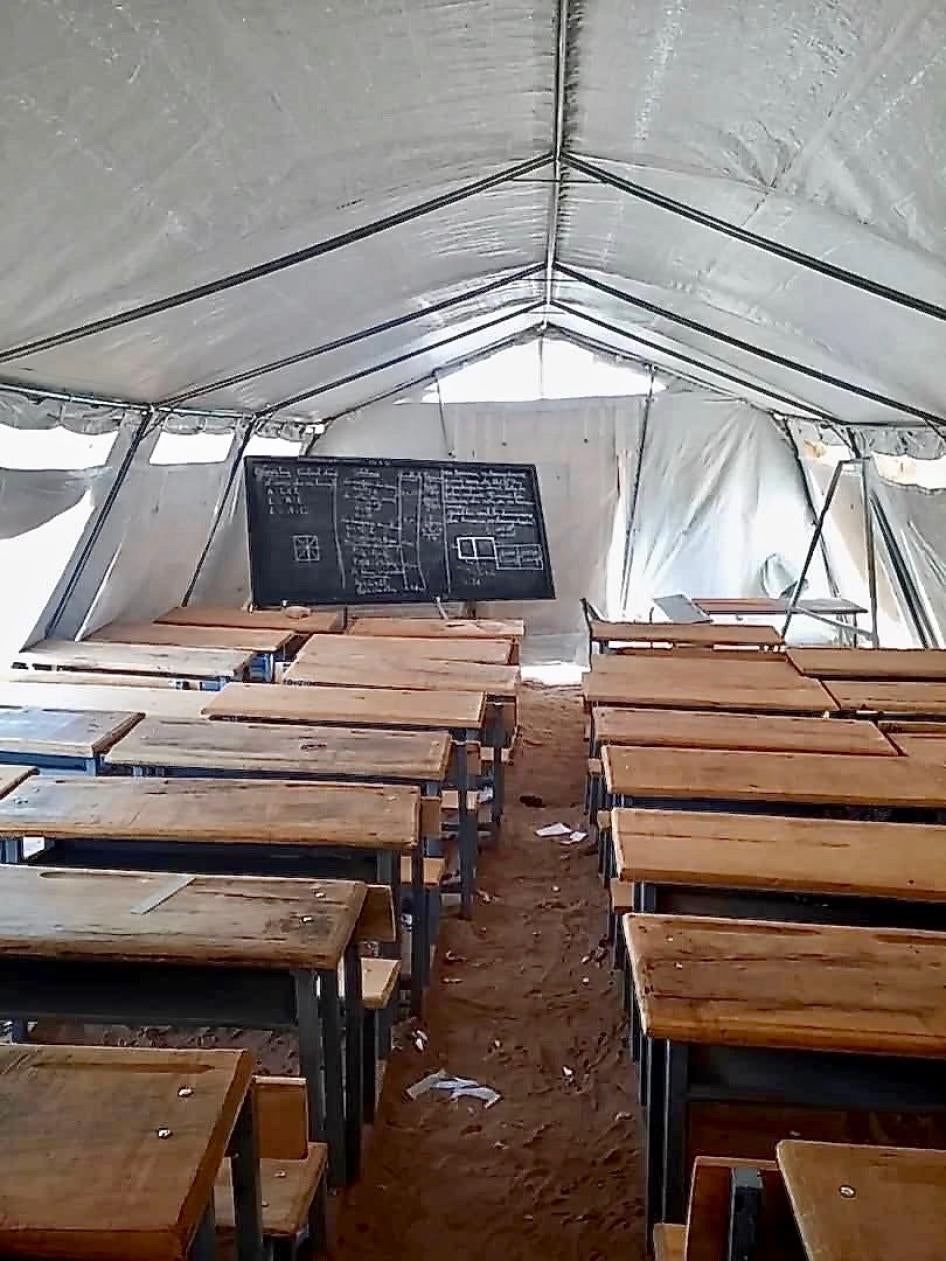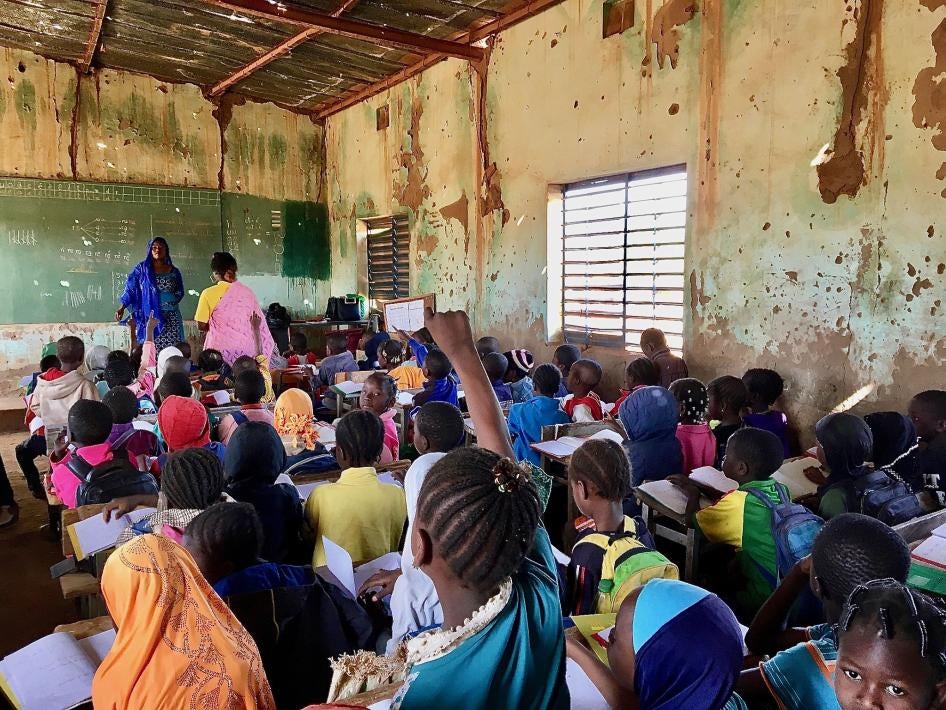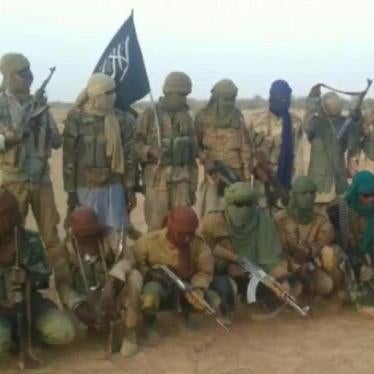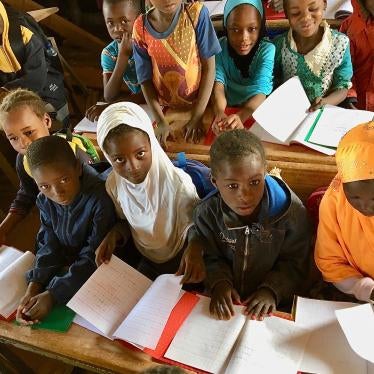Available in Français
Summary
When armed men on motorcycles tore up to a school in Béléhédé village in Burkina Faso’s Sahel region in early 2018, panic ensued. “I was in class when the terrorists came. ... They fired a shot, and we all fled to save ourselves,” said Boureima S. (not his real name), a 14-year-old student at the time. “Afterwards, when we went back there, I saw they had burned the principal’s motorcycle... the [school’s] office... and the students’ notebooks.”
Boureima’s school closed following the attack in 2018 and never reopened. When Human Rights Watch spoke with him in February 2020, he had not yet stepped back inside a classroom. Like hundreds of thousands of students in Burkina Faso, Boureima’s education was cut short by the country’s steadily worsening armed conflict.
Since the first recorded attacks on Burkinabè schools in 2017, the number and severity of such attacks have surged. Armed Islamist groups allied with Al Qaeda or the Islamic State have burned, looted, and destroyed scores of schools. “It’s their war against education,” one teacher said.
The armed groups have also intimidated students, terrorized parents into keeping their children out of school, and killed, abducted, brutalized, or threatened scores of teachers. In many cases, the assailants committed the abuses directly in front of terrified students, leaving both teachers and children physically or mentally scarred.
While armed Islamist groups officially claimed only a few attacks, assailants typically justified their attacks by citing their opposition to “French” education, insisting that children should study only Arabic and the Quran, or not study at all.
These attacks, the terror they generated, and worsening insecurity have resulted in a cascade of school closures across the country, undermining students’ right to education. By early March 2020, the Ministry of National Education, Literacy, and the Promotion of National Languages (“education ministry,” or MENAPLN) reported that over 2,500 schools had closed due to attacks or insecurity in Burkina Faso, negatively affecting almost 350,000 students and over 11,200 teachers. This was prior to the country’s Covid-19 outbreak, which resulted in the temporary closure of all schools from mid-March.
Based on Human Rights Watch interviews with 177 people—including 74 teachers and school administrators, 35 current and former students, 12 parents, and other witnesses to attacks, relatives of victims, community leaders, experts, aid workers, and officials—this report documents attacks on students, education professionals, and schools allegedly carried out by armed Islamist groups in six regions of Burkina Faso between 2017 and 2020.
Burkina Faso has been grappling with armed Islamist insurgent groups since the emergence in 2016 of Ansaroul Islam, a homegrown group with roots in the country’s northern Sahel administrative region. Ansaroul Islam and a patchwork of groups linked to Al-Qaeda in the Islamic Maghreb (AQIM) and the Islamic State in the Greater Sahara (ISGS) regularly attack civilians and civilian objects as well as military targets. These attacks have reportedly caused more than 1,800 deaths.
In 2019, there was a spike in abuses by these groups, including attacks on teachers, students, and schools. In response, the Burkinabè security forces carried out counterterrorism operations that resulted in numerous human rights violations, including the killing of civilians. From January 2019 to April 2020, the number of people displaced from their communities by the conflict skyrocketed from 87,000 to over 830,000, according to the United Nations. Hundreds of teachers were among those who fled.
The bulk of the attacks on teachers, students, and schools occurred in 5 of the country’s 13 administrative regions: Sahel, Nord, Centre-Nord, Est, and Boucle du Mouhoun. However, the most egregious attack to date—the execution of five teachers in a school in April 2019—took place in Centre-Est region. Though Ansaroul Islam and ISGS claimed a small number of the education-related attacks, most went unclaimed.
Documented Attacks and Abuses
Human Rights Watch documented 126 attacks on students, education professionals, and schools occurring between 2017 and 2020. Threatening raids by armed men ordering school closures or teacher departures (28 cases) have been included in the totals. Many additional attacks were reported in the media and elsewhere, suggesting the total number of attacks during this period is likely much higher.
The documented cases include 107 attacks on or at schools, half of which took place in 2019. At least 12 of the attacks on schools involved violence against education workers, and students were present during at least 31 incursions. In 84 cases, attackers damaged, destroyed, or pillaged school infrastructure, materials or supplies. (For a breakdown of all documented attacks by year, region, and type, see Annex I.)
During attacks, armed men killed, beat, abducted, and threatened education workers; intimidated and threatened students; set classrooms, offices, and teachers’ residences on fire; shot at windows, doors, walls and roofs; set off explosives; burned school documents and academic materials; stole, damaged, or destroyed school employees’ property; and pillaged supplies from canteen warehouses and storerooms.
This report documents the targeted killings of 12 teachers and school administrators, as well as three school construction workers, between 2017 and March 2020. Twelve of these fifteen killings took place in 2019.
The report also documents dozens of other attacks on teachers, including assault and abduction. A parent who arrived at a school just after an attack described the horrors he witnessed: “At the school we found the fire still burning. We found the teachers there who had been beaten, some so severely that they couldn’t speak... They were in shock.” One of the teachers said, “Some students... were there watching when they beat us... They were crying.” In another case, a teacher who was abducted, robbed, and threatened said: “They tied my arms, covered my face, and took me away by motorcycle. ... I was so afraid.”
In May 2020, the education ministry reported that 222 education workers had been “victims of terrorist attacks” as of late April.
While children were not targeted for violence during the attacks on schools, at least one child was killed and one injured by stray bullets during attacks at or near schools. Students have also been killed in other attacks on civilians, including seven students returning from school break who were killed in January 2020 when an explosive device detonated under their public transport bus. “I saw my classmates dead,” said one student. Another said he lost a friend in the attack: “It has affected me to the point that I can’t sleep... I’ve continued school, but sometimes I’m following a lesson and I get lost.”
Students have also been threatened and harassed by armed Islamists to stop attending school. Human Rights Watch documented three cases in which students were forced to watch as insurgents destroyed their notebooks. A 16-year-old student recounted: “The jihadists... grabbed our backpacks and took out the notebooks, and they said, ‘Watch closely!’ Then they burned our notebooks.”
Military Use of Schools
Human Rights Watch documented the alleged use of 10 schools by members of the Burkinabè armed forces, the Defense and Security Forces (Forces de Défense et de Sécurité, FDS), for military purposes in Centre-Nord and Sahel regions in 2019, including three occupied as bases for six months to a year. In at least eight cases, the schools had reportedly closed due to insecurity prior to the occupation. For one case, there were conflicting accounts regarding the timeline of the military’s arrival and the school’s closure.
The use of schools for military purposes puts important education infrastructure at risk of damage and destruction in the event of an attack on the soldiers deployed at the school. At least four schools in Burkina Faso were attacked during or directly after the military’s occupation of the schools.
Additionally, presumed armed Islamists carried out the execution of a villager at a school in Sahel region in 2018, and they allegedly occupied at least five schools for short daytime or overnight stays in Centre-Nord region in 2019.
Negative Consequences for Students, Teachers, Society
Burkina Faso already faced major challenges to ensuring education for all children, due to factors such as poverty, poor school infrastructure, poor access, low completion rates, and insufficient numbers of trained teachers, particularly in rural areas. Additional barriers for girls included gender bias, high levels of child marriage, and sexual violence and harassment in and en route to school. The education-related attacks and general insecurity—along with the Covid-19 pandemic—have exacerbated those challenges, reversing decades of progress in increasing school attendance.
Attacks on schools and class disruptions have reduced the quality of education students receive and put many students behind in their studies. One student said that she had failed her final exam after an attack forced her school to close for weeks, leaving her unable to prepare. Another said, “It makes me unhappy, to not be able to finish, to have to retake classes, to not even have any documents to show you took the class. ... You can’t even be sure you will continue your studies.”
Attacks have caused extensive fear-induced withdrawals from schools, as well as long-term psychosocial consequences for students. “Many students don’t even want to look at a school again,” said one teacher. “The attack [on my school] really disturbed me... I don’t have the spirit to go back to school,” said a former student.
Other students, despite the countless barriers in their way, are determined to return to school. “I want to go to school because it’s good,” said a 15-year-old girl who had been out of school for an entire academic year. “I want to be a teacher.”
In their desperation to continue classes, many children affected by school closures enrolled in schools in towns away from home. Some began commuting long distances, exposed to risks on the road. Others moved to towns to live in groups of children, without an adult family member, putting them at risk of exploitation and violence. These children often live in squalid conditions, struggling to pay for food and school fees.
This report also documents cases of child labor resulting from school closures, including out-of-school children working in the markets, as domestic help, in gold mines, and making bricks. It also explores how girls may be less likely to be re-enrolled in school than boys and face increased risks of child marriage when out of school.
Teachers have also suffered devastating consequences as a result of attacks, including trauma, physical problems, and loss of everything they owned. “[They] set a fire in my house. ... I found everything charred—there was nothing left,” said one teacher. “I get migraines... my head and entire body hurts,” said another. At least two pregnant teachers experienced miscarriages following attacks on schools.
Attacks on education can have an incalculable long-term effect on society. “Large numbers of children will miss out on the education necessary for their cognitive and social-emotional development, which will make them vulnerable to armed terrorist groups. That’s what the terrorists want—children to be ignorant, so they can influence them and put whatever they want in their heads,” said Jacob Yarabatioula, a Burkinabè researcher specializing in terrorism. “We all should fear this.”
Legal Protections
During an armed conflict such as is occurring in Burkina Faso, international humanitarian law, or the laws of war, apply to both national armed forces and non-state armed groups. Deliberate or indiscriminate attacks on civilians including teachers and students, as well as on civilian objects such as schools, are violations of the laws of war. Individuals who ordered or were involved in such attacks, including summary executions, torture and other ill-treatment, arbitrary detention, and looting, are responsible for war crimes.
Attacks on schools may also deprive students of their right to education, protected under international human rights law, notably the International Covenant on Economic, Social and Cultural Rights and the Convention on the Rights of the Child.
In 2017, Burkina Faso endorsed the Safe Schools Declaration, a political agreement committing countries to a range of measures aimed at strengthening prevention and response related to attacks on students, teachers, and schools. By doing so, Burkina Faso committed to using the Guidelines for Protecting Schools and Universities from Military Use during Armed Conflict, which urge parties to armed conflicts not to use schools—and particularly not functioning schools—“for any purpose in support of the military effort.”
Responses and Needs
The Burkinabè government has taken important steps to implement measures in line with the Safe Schools Declaration. These initiatives, notably those aimed at ensuring continued access to education, included creating a national strategy and technical secretariat on “education in emergencies,” redeploying teachers, working to reopen schools, organizing catch-up sessions for students, and instructing schools to enroll displaced students “systematically and without fees.”
Though the international humanitarian response plan in Burkina Faso remains underfunded, aid agencies have provided crucial support to government efforts and partnered on several initiatives, such as setting up temporary learning spaces.
This report identifies several gaps and needs in the response efforts to date, including the insufficient resources, personnel, and infrastructure devoted to schools enrolling displaced students. “The schools are saturated!” said a local official in Centre-Nord region prior to the Covid-19 closures. “One class can have up to 150 students,” a teacher reported.
Another problem is the lack of psychosocial support to teachers and students who experienced education-related attacks, as well as delayed or nonexistent government compensation to teachers who lost property in attacks by armed groups. “The attack hurt me very much, but the fact that after the attack, we weren’t supported... that’s what still bothers me,” said one teacher.
Other issues include the lack of adequate security for many schools operating in at-risk regions, as well as the government’s failure to regularly collect and share sufficient data on education-related attacks and military occupation of schools, which can hinder response efforts.
The Burkinabè government should immediately address these issues, and its humanitarian and international partners should consider increasing their support to meet the identified needs. Authorities should pay attention to the ways in which school closures differently impact boys and girls, and should address the particular challenges to education for girls.
The government should also take concrete measures to deter the use of schools for military purposes, drawing upon examples of good practice by other African Union countries, and at a minimum implementing the Guidelines on Protecting Schools and Universities from Military Use during Armed Conflict.
Armed Islamist groups should cease all attacks on teachers and schools, extrajudicial killings, abductions, and other serious laws-of-war violations and human rights abuses.
Students, parents, and teachers have suffered immensely as a result of attacks on education in Burkina Faso. Education has become one of the greatest casualties of the conflict, crushing the hopes of hundreds of thousands of children for a better future.
During times of insecurity, maintaining access to education is vital. If children remain in safe and protective environments, schools can provide an important sense of normalcy essential to children’s development and psychological well-being.It is crucial that a generation of children in Burkina Faso do not lose access to education.
Recommendations
To the Burkinabè Government
- During the period in which schools remain closed as a result of the Covid-19 pandemic, prioritize and expand efforts to continue education for all children through available distance-learning programs, including educational radio and television programming and online education resources, as well as contextually-tailored approaches for localities with limited access to these technologies.
- When schools are reopened nationally after Covid-19 lockdowns are lifted, ensure that all children regain access to education. In particular:
- Ensure that students deprived of access to education as a result of armed conflict are promptly given access to accessible alternative schools.
- In areas where children are unable to enroll in schools, ensure the provision of alternative learning opportunities such as community education, distance learning, and temporary learning spaces.
- Ensure that any post-Covid-19 “back-to-school” campaigns and remedial classes are inclusive of children who previously stopped studies due to attacks on schools, insecurity, or displacement; and continue and expand distance-learning programs established in response to Covid-19 to benefit these children.
- Encourage parents who had withdrawn their children from school due to fear of attack to re-enroll them, or to make use of distance learning programs or temporary learning spaces.
- Consider implementing special education outreach programs for displaced children who have never attended school, including those from nomadic Peuhl communities.
- Rebuild and re-equip damaged or destroyed schools as soon as possible.
- Increase support to overloaded “host schools” taking in large numbers of displaced students, with a view to expanding their capacity, including by constructing additional classrooms, deploying additional teachers, and providing more desks, materials, and canteen food supplies.
- Take greater measures to protect schools that are operating in high-risk areas, including by setting up prevention measures (risk mapping and early warning systems) and rapid reporting and response systems for attacks on schools. This should include setting up a hotline for teachers and parents to quickly report threats or attacks on schools to local security forces and education authorities.
- Take concrete measures—for example, through legislation, standing orders, and training—to deter the military use of schools, drawing upon examples of good practice by other African Union countries, and at a minimum implementing the Safe Schools Declaration and the Guidelines on Protecting Schools and Universities from Military Use During Armed Conflict.
- Develop and expand the work and capacity of the Technical Secretariat for Education in Emergencies.
- Consider permitting teachers to adopt alternate listings for their “profession” on their national identification cards, in order to decrease their risk of being targeted.
- Address barriers to girls’ education, including implementing nationwide programs to empower girls to attend school and ensuring that “education in emergencies” responses address the particular needs of pregnant girls and young mothers of school-going age.
To the Burkinabè Defense and Security Forces
- Take greater steps to ensure the protection and security of schools operating in high-security risk areas, including by increasing patrols, while minimizing activities that would turn schools into military targets.
- Vacate all schools being occupied as military bases where feasible alternatives exist, and where they do not, take steps to identify or create feasible alternatives. Increase logistics planning and supplies to minimize the need to use schools, and consider using temporary accommodations such as tents.
- Order commanding officers not to use the buildings or property of functioning schools for military purposes such as camps, barracks, or deployment. Draw upon examples of good practice by other African Union countries and implement the Guidelines for Protecting Schools and Universities from Military Use during Armed Conflict, which Burkina Faso committed to use by endorsing the Safe Schools Declaration in 2017.
- Incorporate protections for schools from military use in military doctrine, operational orders, trainings, and other means of dissemination to ensure compliance throughout the chain of command.
- Ensure that doctrine and trainings applicable to Burkinabè armed forces being deployed on United Nations peacekeeping missions reflect the requirement of the UN’s 2012 Infantry Battalion Manual that “schools shall not be used by the military in their operations.”
To the Ministry of Education
(Ministry of National Education, Literacy, and the Promotion of National Languages)
- Ensure availability and accessibility of schools, effectively implement the Safe Schools Declaration, and work with school authorities, community leaders and parents to ensure better security for schools in conflict-affected regions.
- Ensure that teachers and administrators are not pressured to reopen schools in insecure zones where there are credible threats to their safety, without appropriate security measures.
- Ensure that public schools follow the ministry’s instructions to eliminate school fees for displaced students.
- Designate a fund to support schools hosting displaced students, and ensure they have adequate personnel, infrastructure, and equipment.
- Extend temporary learning spaces (both temporary classrooms for formal schooling, and “child-friendly” spaces) and other “education in emergencies” programs to reach additional towns and sites hosting large numbers of displaced people, prioritizing those that have not yet benefitted from these programs.
- Provide timely compensation to education workers who suffered property loss or injury in targeted attacks, and take steps to share information and increase public communication regarding public school employees’ entitlements in this regard.
- Expand data collection efforts to include the following, disaggregated by gender:
- Attacks on students, teachers, and schools: date and location; type of school; victims and suspected perpetrators; number of students affected.
- Military use of schools: types and locations of schools being used; purpose and duration of use; the unit or group making use of the school; whether the school had ceased functioning prior to military occupation; student attendance prior, during, and after the period of use.
Support to Schools in Conflict-Affected Areas
- Take greater steps to ensure the protection of schools operating in high-risk areas, including by implementing protocols and a rapid reporting and response mechanism (with a hotline) for school attacks, in order to ensure that the relevant authorities are informed, and timely assistance provided.
- Extend training in risk mitigation and emergency response to cover all schools in at-risk areas and assist schools to develop individualized plans.
- Improve school infrastructure and construct walls or fences around schools as needed, in order to provide some measure of increased protection.
- Equip all schools, including those rebuilt or rehabilitated following attacks, with adequate facilities for menstrual hygiene management.
To the Ministries of Education and Humanitarian Action
(Ministry of National Education, Literacy, and the Promotion of National Languages; Ministry of Women, National Solidarity, Family, and Humanitarian Action)
Support to Victims and Witnesses of Attacks
- Ensure that all teachers and school administrators who are victims of attacks receive timely, appropriate, and subsidized medical and psychosocial support, and ensure that such support includes follow up.
- Dispatch appropriate medical and psychosocial experts to the victim’s location, or as near as possible, to ensure that victims are not required to travel long distances to obtain care. If victims are required to travel, ensure that transportation, lodging, and other expenses are covered.
- Inform all public-school teachers about how they can access free support services.
- Establish a system to follow up with students who have witnessed attacks in order to assess their psychological and emotional well-being, and provide counseling services or other treatment as necessary.
Reducing Negative Impacts on Children
- Develop and implement measures to remedy the disproportionate impact of school closures on girls, including by working to reduce child marriage and adopting measures to assist girls who have lost access to education.
- Follow up on reported cases of children living alone to continue their studies, to ensure these children are placed in the care of an adult family member or guardian.
- Implement programs to support out-of-school children and reduce child labor.
- Proceed with the establishment of Community Child Protection Units as soon as possible, and ensure that units are set up in displacement camps and sites.
To the Ministry of Justice
- Ensure impartial investigation and appropriate prosecution of members of armed Islamist groups implicated in unlawful attacks on students, teachers, and schools, and for other abuses of international human rights and humanitarian law.
To Armed Islamist Groups in Burkina Faso
- Cease all violations of the laws of war, including attacks on civilians and civilian structures related to education, such as the killing, abduction, assault, robbery, and intimidation of teachers, school administrators and students; and the looting, burning and damaging of schools.
- Cease human rights abuses against students and teachers, as well as threats undermining children’s right to education.
- Cease the indiscriminate use explosive devices, including on routes used by civilian vehicles.
- Refrain from using schools for military purposes.
To Burkina Faso’s International and Regional Partners
- Urge the Burkinabè government and military to adopt the above recommendations and support their implementation.
- Continue to support and consider expanding “education in emergencies” programs in Burkina Faso, notably to benefit still-unreached children affected by conflict-related school closures, as well as to build capacity among “host schools” accepting large numbers of displaced students.
- Support victim rehabilitation in Burkina Faso, including psychosocial care for teachers and students who experienced attacks.
To the United Nations
- The UN secretary-general should include Burkina Faso in his annual report on children and armed conflict to the UN Security Council, initially as a situation of concern, pending the establishment of a monitoring and reporting mechanism.
- Pending the establishment of a formal Monitoring and Reporting Mechanism on children and armed conflict, the UN country team should actively document and verify cases of grave violations against children, including attacks on students, teachers, and schools, and provide this information to the special representative to the secretary-general for children and armed conflict. The special representative should also actively request this information.
Methodology
The report is based on in-person interviews conducted in the cities of Ouagadougou and Kaya in Burkina Faso during four weeks between December 2019 and February 2020, as well as telephone interviews conducted between December 2019 and April 2020. The attacks documented took place between January 2017 and March 2020.
Human Rights Watch interviewed 177 people, including 74 education professionals, 35 current or former students, and 12 parents of students. The current and former students included 22 children (13 girls, 9 boys) ages 10-17, and 13 young adults (9 women, 4 men) ages 18-26. The remaining interviews were with witnesses to abuses, relatives of victims, civil society members, community leaders, humanitarian workers, UN officials, security analysts, education ministry officials, and local government officials.
Interviewees included current or former residents of seven regions: Boucle du Mouhoun, Centre, Centre-Est, Centre-Nord, Est, Nord, and Sahel.
Interviews were conducted in French, Mooré (spoken by ethnic Mossi), and Fulfulde (spoken ethnic Peuhl). Interviews in Mooré and Fulfulde were conducted with interpreters.
To maintain security for interviewees, all in-person interviews were conducted in or around Ouagadougou, the capital, and Kaya, a city in Centre-Nord region. Some individuals travelled to these cities for the interviews, while others were already there, having previously fled violence.
Nearly all survivors of attacks and witnesses to abuses by armed Islamist groups expressed extreme anxiety about their identities being revealed. Names and identifying information of many interviewees have therefore been withheld to protect their safety. All children’s names have been withheld or replaced by pseudonyms.
The Human Rights Watch researcher informed all interviewees of the nature and purpose of the research, and of Human Rights Watch’s intention to publish a report with the information gathered. The researcher obtained oral consent for each interview and gave each interviewee the opportunity to decline to answer questions. Interviewees did not receive material compensation for speaking with Human Rights Watch, however travel expenses incurred by interviewees were reimbursed.
On April 20, 2020, Human Rights Watch sent three letters to the Burkinabè government: one to the education ministry; one to the humanitarian action ministry; and one to the Burkinabè ambassador to the United States, requesting that the letter be transmitted to the prime minister and the ministries of defense, security, justice, and human rights. The letters presented our preliminary findings and included questions on the government’s responses to education-related attacks and the military use of schools.
On May 18, 2020, Human Rights Watch received two letters, one from the education ministry and one from the humanitarian action ministry, with detailed responses to our questions. Certain elements of these responses have been integrated into the report, and the letters are included as Annexes II and III.
Terminology
Students: A “student” may refer to a child (under age 18) or an adult (18 or older). In Burkina Faso, many students begin school late, or stop and restart, with the result that primary to secondary students can range from 6 to around 25 years old, or sometimes older.
Teachers: In Burkina Faso, all teachers are referred to as enseignants. Primary school teachers are also called instituteurs or maîtres; middle school and high school teachers are also called professeurs.
School principals: Directeurs for primary and middle schools; proviseurs for high schools. Many also teach classes, and thus may be considered both teachers and administrators.
“School administrators”: May include principals, supervisors, bursars, treasurers, stewards, and others.
“Education professional”: Teachers, school administrators, members of teachers’ unions, or local education officials (such as basic education district inspectors).
School year in Burkina Faso: October to June.
School levels in Burkina Faso:
- Primary school (école primaire): grades CP1, CP2, CE1, CE2, CM1, CM2
- Post-primary school / middle school (école post-primaire, or collège d’enseignement générale): grades 6ème, 5ème, 4ème, 3ème; BEPC exam
- Secondary school / high school (école secondaire, or lycée): grades seconde, première, terminale; BAC exam
- Note: some combined schools include both post-primary and secondary levels.
I. Conflict and Education in Burkina Faso
Spreading Armed Islamist Activity
Across the West Africa portion of the Sahel—a vast semi-arid region south of the Sahara Desert—armed conflict and violence among non-state armed groups and national armed forces, underscored by the growing presence of armed Islamist groups, has led to a humanitarian and security crisis. In Mali, Niger, and Burkina Faso, over 4,000 people were killed in 2019 alone, according to one estimate, and over 1.1 million people were displaced by early 2020.[1]
In January 2020, the United Nations called the levels of violence “unprecedented.”[2] Perpetrators of violence against civilians include armed Islamist groups allied to Al Qaeda and the Islamic State; ethnic self-defense or separatist groups; and state security forces. Human Rights Watch previously reported that abusive counterterrorism operations and unlawful killings of suspects in custody, as well as abusive self-defense groups, are widely believed to have pushed many into the ranks of the armed Islamist groups.[3]
A landlocked nation of 20 million people, Burkina Faso spiraled from a largely peaceful—while imperfect—democracy in 2016 to a country struggling in 2020 to cope with over 830,000 people displaced from their homes, 2.2 million people (including 1.2 million children) in need of humanitarian assistance,[4] and attacks of varying frequencies by armed insurgents across at least 7 of its 13 regions. In January 2020, a state of emergency was extended in provinces of six regions for another year.[5] The number of killings multiplied from about 80 in 2016 to over 1,800 in 2019, according to the UN.[6]
The growing presence of armed groups in Burkina Faso is linked to insecurity in neighboring Mali, where northern regions fell to separatist Tuareg and Al-Qaeda-linked armed groups in 2012.[7] From 2015, armed Islamist groups spread to central Mali, and from 2016, with the emergence of Ansaroul Islam, into Burkina Faso.[8] Initially concentrated in Burkina Faso’s Sahel region, armed Islamist activity steadily spread to the Nord, Est, Boucle du Mouhoun, and Centre-Nord regions, which together have suffered the bulk of the attacks, as well as to Centre-Est and Centre-Sud. Additional attacks have occurred in other regions.[9]
A patchwork of groups with shifting and overlapping allegiances are involved in—and have claimed responsibility for—the attacks, including the homegrown Burkinabè armed Islamist group Ansaroul Islam, the Islamic State in the Greater Sahara (ISGS), and Al-Qaeda in the Islamic Maghreb (AQIM) and its affiliates, notably the Group for Support of Islam and Muslims (JNIM).[10]
Education in Burkina Faso
Burkina Faso’s 2007 education law declares education a “national priority,” guarantees everyone the right to education, and makes schooling compulsory from ages 6 to 16. The law guarantees free basic public education, excluding registration fees.[11]
In practice, public education in Burkina Faso is not free. Communities frequently take on responsibility for constructing primary school buildings and teachers’ housing or keeping school supplies stocked. As a result, community parents’ associations, which manage much of the upkeep of local schools, often impose registration fees on students. This remains a financial barrier to education for many families.[12]
Schools in Burkina Faso include government public schools, private schools accredited by the government, and unaccredited private schools. Traditional Quranic schools (foyers coraniques) are not integrated into the formal education system.
Even prior to the security crisis, Burkina Faso’s education system faced serious challenges including lack of qualified teachers, overcrowded classrooms, insufficient infrastructure and teaching materials, low completion rates, and gender bias.[13]
Many school buildings remain unfinished, lacking boundary walls for protection and sufficient classrooms, desks, or materials. In rural areas, schools often operate under a thatched canopy outdoors.[14] Public school teachers are frequently deployed to areas outside their localities of origin, and many schools include teacher housing located on school grounds or nearby. However, in schools without housing, some teachers sleep in classrooms, offices or warehouses.[15]
The government made notable progress during the decade prior to the conflict in improving girls’ access to education. For example, primary school net enrollment rates[16] for the 2001-2002 school year were 30 percent for girls and 42 percent for boys; completion rates were 23 percent for girls and 34 percent for boys. As of the 2015-2016 school year, prior to the conflict, primary school net enrollment rates were 71 percent for both girls and boys; completion rates were 61 percent for girls and 55 percent for boys. For post-primary (middle) school, girls had also achieved parity with boys in enrollment rates, and near-parity in completion rates.[17]
Nevertheless, girls in Burkina Faso still face particular barriers impacting their education, including high levels of child marriage, female genital mutilation, and sexual violence and harassment in and en route to school.[18] Although the government adopted a strategy to prevent teenage pregnancies, some school officials still reportedly ban pregnant girls from school due to social norms and stigmas.[19]
Gender disparities persisted in access to secondary education both prior to and during the conflict, with girls still lagging slightly behind boys in secondary (high) school enrollment, and even more so behind boys in secondary school completion.[20]
Negative Consequences of the Conflict on the Education System
The conflict and attacks on education have greatly compounded the preexisting challenges and further eroded education infrastructure. Frequently, attacks on teachers or schools not only resulted in the closure of the school concerned, but provoked “cascades” of school closures and the panicked flight of teachers from neighboring communities.[21] Additionally, at least 62 schools were used by displaced people seeking shelter in 2019.[22]
As of March 10, 2020, the education ministry reported that 2,512 schools were closed due to insecurity—a surge of more than 1,000 schools since the end of the previous academic year—affecting 349,909 students and 11,219 teachers.[23] This meant that around 13 percent of Burkina Faso’s schools (preschool to secondary) had already closed due to attacks or insecurity prior to the Covid-19 outbreak, which resulted in the closure of all schools from mid-March.[24]
Of the five regions most affected by the conflict-related school closures, Sahel region topped the list in early March with a reported 947 schools closed (80 percent of the region’s schools), followed by 556 schools in Est (38 percent), 366 in Centre-Nord (21 percent), 357 in Nord (18 percent), and 239 in Boucle du Mouhoun (13 percent). The remaining closed schools were in Centre-Est (46) and Centre-Sud (1).[25]
While enrollment and completion rates for primary, post-primary, and secondary school in Burkina Faso had increased every year between 2015 and 2018, they decreased for the 2018-2019 school year for primary and post-primary school,[26] likely in response to surging attacks during that period.
Prior to the Covid-19 crisis, the Burkinabè government had reopened at least 840 schools as of early March 2020,[27] in addition to other steps to ensure continued access to education for displaced children and those affected by school closures. These efforts are examined in section VIII.
|
Burkina Faso: School Enrollment and Completion Rates During the Conflict |
|||||||||
|
2017-2018 School Year |
|||||||||
|
|
Primary |
Post-Primary (Middle School) |
Secondary (High School) |
||||||
|
Girls |
Boys |
All |
Girls |
Boys |
All |
Girls |
Boys |
All |
|
|
Net enrollment rate |
74.1% |
74.4% |
74.3% |
29% |
26.2% |
27.6% |
4.7% |
6.1% |
5.4% |
|
Gross enrollment rate |
90.9% |
90.6% |
90.7% |
54.6% |
49.6% |
52% |
14.5%, |
20.6% |
17.6% |
|
Completion rate |
67.6% |
58.8% |
63% |
42.1% |
39.2% |
40.6% |
11.9% |
17.7% |
14.8% |
|
2018-2019 School Year |
|||||||||
|
|
Primary |
Post-Primary |
Secondary |
||||||
|
Girls |
Boys |
All |
Girls |
Boys |
All |
Girls |
Boys |
All |
|
|
Net enrollment rate |
72.7% |
72.8% |
72.7% |
28.4% |
24.9% |
26.6% |
6.1% |
7.1% |
6.6% |
|
Gross enrollment rate |
89.2% |
88.4% |
88.8% |
54.1% |
47.1% |
50.5% |
19% |
24.2% |
21.6% |
|
Completion rate |
66.3% |
57.4% |
61.7% |
41.7% |
36.3% |
39% |
12.9% |
17.8% |
15.4% |
|
*Rates in red show decreases from prior year, likely due to increasing insecurity and attacks on schools. |
|||||||||
Data source: MENAPLN, “2018/2019 Statistical Yearbooks” for primary, post-primary and secondary school.
II. Perpetrators of Attacks on Teachers, Students and Schools
Most of the attacks on students, teachers, and schools documented by Human Rights Watch were unclaimed. However, the Islamic State in the Greater Sahara (ISGS) and Ansaroul Islam identified themselves or claimed responsibility in a few cases.
During a November 2018 attack on a middle school in Toulfé, Nord region, in which five teachers were whipped and the school burned, the attackers orally stated they were with Ansaroul Islam and left a signed note.[28]
ISGS reportedly took responsibility for the April 2018 abduction of primary school teacher Issouf Souabo in Soum province, Sahel region.[29] Additionally, in a video circulated in early 2019—which reportedly depicts the October 19, 2017 burning by several armed Islamists of a school in Tem commune, Soum province, Sahel region—attackers spoke Fulfulde and Arabic and “identified themselves as ‘soldiers of the Islamic State in Burkina Faso and Mali [ISGS],’” according to an analyst for the Middle East and North Africa security research group MENASTREAM.[30]
During a 2018 attack on a primary school in Centre-Nord region, according to an eyewitness, armed men carried a black flag with white Arabic script similar to both Al Qaeda and Islamic State flags.[31] In a 2020 attack on a school in Est region, armed men told teachers “they were jihadists” and ordered them to stop classes.[32]
Witnesses, community members, and security sources widely presumed armed Islamist groups—most notably Ansaroul Islam, but also ISGS and the Group for Support of Islam and Muslims (JNIM)—to be behind the unclaimed education-related attacks across the country.
In dozens of cases documented by Human Rights Watch, survivors recounted that the perpetrators—typically armed with Kalashnikov military assault weapons, wearing either military uniforms or longer traditional garments (boubous), and often wearing turbans with their faces covered—gave speeches before, during, or after their attacks stating their position against education and issuing threats. In nearly all cases, attackers stated that they were against “French education,” “classic education,” or the education of “whites”; and that teachers “should only be teaching Arabic” or the Quran.[33]
Attackers typically issued variations of the same threat, as recounted by scores of witnesses: “If we return and find anyone here [at the school] again” or “anyone here teaching in French,” “we will kill you.” They often denounced “anything connected to the government,” to “whites” or to “Europeans.”[34] All of these threats aligned with the stated ideology of armed Islamist groups.
III. Attacks on Teachers and Education Professionals
Attacks and abuses against teachers, principals, school staff, and other education professionals—anyone perceived to be promoting government-run, French education in Burkina Faso—have steadily increased since 2017, when the first principal, Salifou Badini, was killed in Sahel region. These attacks, mostly targeting teachers, have included killings; violent assault; physical restraint including tying, chaining and blindfolding; robbery and destruction of personal property; and threats and intimidation. Principals, many of whom also teach, were often sought out for particularly harsh treatment.
Human Rights Watch documented the execution-style killings between 2017 and 2020 of 15 people allegedly targeted by armed Islamist groups for their connection to education. Human Rights Watch also documented the assault, abduction, or detention of 20 education professionals by presumed armed Islamists between 2018 and 2020. Abductions lasted between a day and two months.
Incidents took place in six regions: Sahel, Nord, Centre-Nord, Boucle du Mouhoun, Est, and Centre-Est. During seven attacks, assailants also damaged or destroyed school infrastructure or materials. Seven attacks were perpetrated in front of students.
In dozens of other cases documented by Human Rights Watch, teachers and school employees were threatened, often with death, and ordered to cease teaching in French or to leave the locality. In some cases, teachers were also robbed or suffered destruction of personal property.
Among the cases documented, all of the education professionals targeted for the gravest attacks—killings, violence, abduction—were men. Both male and female teachers were victims of threats, intimidation, robbery, and property destruction. According to survivors and witnesses, victims were of various ethnicities including Mossi, Peuhl, Gourmantché, Bobo, and Foulsé, while attackers most frequently spoke Fulfulde (a language of the ethnic Peuhl), followed by Moore (spoken by the Mossi), Gourmantché, Dioula, French, and, in at least one instance, Tamasheq (spoken by the Tuareg or Bella).
In a May 2020 letter to Human Rights Watch, the education ministry reported that 222 education workers had been “victims of terrorist attacks,” including 12 killed and others who were assaulted, robbed, or had their property destroyed.[35]
Targeted Killings
No one claimed responsibility for the 15 killings documented by Human Rights Watch, which included 12 education professionals killed in seven attacks between March 2017 and February 2020, and three construction workers killed at a school in April 2019. The attacks took place in Sahel region (six killings), Centre-Est (five), Nord (three), and Est (one).
Of the 12 education professionals killed, nine were working in public schools at the time; two were teachers reportedly working for local education authorities; and one was a village chief and retired teacher who taught on a voluntary basis. Ten individuals were shot, while two were beheaded. Seven were killed in front of students.
Several teachers and community leaders suggested to Human Rights Watch that two early teacher killings, in 2017, may have been reprisals by Ansaroul Islam against teachers who had joined Ansaroul founder Malam Dicko’s early religious association Al-Irchad—receiving benefits such as land, houses, and debt repayment—but who had refused to support the group’s evolution into an armed insurgency.[36]
However, relatives, witnesses, analysts, and education professionals attributed many subsequent killings of teachers to armed Islamists’ broader agenda of stopping “French” education and ridding territory of government workers, though there may also have been additional motivations for the attacks.[37]
February 2020 (Nord): School Administrator Abducted, Killed
The body of Ali Zorome, an administrator at Loroum Provincial High School in Titao, was found by soldiers near Samboulga village in Sollé commune on February 22, 2020.[38] A teacher at Zorome’s school said: “[Zorome] had gone to visit his family in Sollé, and he’d left on February 8 to return. Along the way, he was abducted. ... The next day when they called his phone, somebody else answered, so they knew something had happened. [The abductors] held him for two weeks.”[39]
While the motivation behind the killing is unclear, attacks against schools and teachers had previously taken place in Loroum and neighboring provinces, suggesting that Zorome’s profession may have been a factor. Two days later, in the neighboring province of Yatenga, two cases of teachers “brutalized” and “intimidated” by armed men were reported in the localities of Tangaye and Bossomnoré.[40]
December 2019 (Est): Village Chief, a Volunteer Teacher, Killed
The night of December 28, 2019, armed Islamists attacked the family compound of the Gourmantché community village chief in Nadiabonli village, in Partiaga commune, Tapoa province. The attackers shot and killed the chief, Kondjoa Marcellin Tankoano, who also volunteered as a teacher and tutored students. “We the family know this [attack] was linked to education, because he was the only intellectual in the village... and he taught those that needed help... and [the armed Islamists] were against this,” said a relative.[41]
The chief, about 75, had previously worked as a teacher in Cascades region, according to relatives. Upon retirement, he returned to his village, oversaw the construction of a middle school funded by private donors, and taught there as a volunteer, in addition to tutoring children in the evenings.[42] A family member said:
The schools in the commune were already under threat... Just two to three kilometers away, [armed Islamists] had kidnapped teachers. ... By late 2019, the middle school was functioning irregularly. ... The chief often went to the school to help teach, since there were frequently teachers absent. In the evenings, he helped children who hadn’t understood the lessons.
That night, around 9 p.m., he was giving exercises in math, physics and chemistry to students. ... He was in [his family] courtyard, seated on his terrace, where he had a chalkboard to write the lessons. The children were on benches that he’d made himself. Suddenly, armed men entered the royal court, shouting, “The chief, the chief, where is he?” There was a struggle, and they shot him in the head in front of the students. They are still traumatized.[43]
Another relative noted, “They had burned schools [in Partiaga], and it stung him to see young girls and boys out of school. After teachers started fleeing, he said he’d continue to teach. ... He was someone who truly had a heart for education.”[44] A teachers’ union representative said that after seven schools were attacked in the commune in 2019, many had closed. “The chief had encouraged teachers not to leave,” he said. “After he was killed, all the commune’s schools closed for a month.”[45]
October 2019 (Sahel/Nord): Principal Abducted, Killed
On October 26, 2019, the body of Souleymane Ouedraogo, principal of a primary school in Pobé-Mengao in Soum province, was found in Rounga village in Ouindigui commune, Loroum province. According to a government communiqué, “on his return from a teacher’s conference held in Djibo, [Ouedraogo] was abducted on Friday, October 25, 2019 by a group of armed individuals, at around 2 p.m.”[46] A member of the Kogleweogo self-defense militia in Ouindigui described seeing Ouedraogo’s body:
We heard shots fired the night before around 6 p.m., and we waited until the morning. Some of the population sent us a message to come... So we went to Rounga village, some 20 of us Kogleweogo militia. ... We saw the body two meters from the road, at the marketplace. They had shot him in the head. He was lying on his stomach... part of his head had been blown away.[47]
April 2019 (Centre-Est): Five Teachers Killed in School
The deadliest attack against teachers took place on April 26, 2019 in the village of Maytagou, Koulpélogo province, when armed men shot five teachers at the public primary school. The victims included the principal and two teachers—Désiré Bancé, Dieudonné Sandwidi, and Pakiemdan Sabdano—as well as Alassane Yougbaré and Hamad Bouda, two teachers at the Centre à passerelle (a “bridging center” reintegrating children into the education system), which operated in one of the classrooms.[48] A witness said that a sixth teacher was spared to be a “messenger to tell everyone in Burkina [they] don’t want anyone teaching French.”[49]
The witness said that about 10 armed men arrived on motorcycles in the late afternoon, while students were still in class. They wore military attire, and some had their faces covered with turbans. They spoke French, Moore, and Fulfulde. The teachers tried to run, but were caught, and the attackers fired in the air as warning.[50] The witness recounted:
When they arrived, some students fled, but others the jihadists rounded up to bring them into the classrooms... maybe 50 or so students, ages 6 to 16, were there. ... One of the teachers, Mr. Yougbaré... since he [resisted], they let him fall [in the schoolyard], and they shot him three times – in the head, stomach, and thigh. He was the first one they killed. ... [The attackers] gathered papers, documents, clothes, and set fire to it all inside the warehouse... Then they had the other teachers bring them their motorcycles. ... They said, “Didn’t you hear we’d told the population that we didn’t want you to teach French? ... Didn’t you follow the TV or the radio?”...
They took the principal and two teachers in front of the warehouse... They took Mr. Bouda separately in front of the building with the CP1, CP2, and CE1 classrooms. One started to shoot Mr. Bouda. He fired three shots, and with each shot he said “Allahu Akbar.” Then three others started to shoot the principal and the two teachers—they also shot them three times in the head, stomach and thigh, also saying “Allahu Akbar.” ... When they killed Mr. Bouda, it was in front of classrooms where the students were. Some were watching. The youngest were crying.[51]
A student’s parent said:
The next morning, I went to the school and found the five bodies on the ground... they’d been shot in the head and body. My son [age 8] and brother’s children [ages 7 and 13] had been at school that day... The children were traumatized... The school was closed, and they were not able to complete the school year.[52]
April 2019 (Sahel): Three School Construction Workers Killed
On April 19, 2019, armed men killed three workers building teachers’ residences at a primary school in Djika village, Arbinda commune, Soum province.[53] A villager who was at his home, some 300 meters away, said he saw around 20 to 30 armed men entering the school. “They found three people at the school, and they killed them. They were a 26-year-old contractor and two masons, ages 35 and 32,” he said. “The next day at 6 a.m., I went to the school and saw the bodies. They’d been shot in the head. ... I also saw they had burned the school hangar [a covered area], forced the doors, burned the desks and the teachers’ offices.”[54]
March 2019 (Sahel): Two Teachers Abducted, Killed
On March 19, 2019, the decapitated bodies of two primary school teachers, Judicaël Ouedraogo and Al-Hassane Cheickna Sana, were found on the road near Koutougou, Soum province. The teachers, both men, had been abducted on March 11 while traveling by motorcycle from Kongoussi, Centre-Nord region, to Djibo, Sahel region, where they worked.[55] Ouedraogo previously taught at a primary school in the Djibo area until late 2018, when he transitioned to working for the local education authorities in Djibo.[56]
A member of the Kogleweogo self-defense militia in Koutougou recounted finding the bodies on the road:
On March 18, around 6 p.m., I heard shots from the direction of the Koutougou CSPS [health center], around 800 meters from the village exit. I thought it was the [security forces] who were shooting, but the next day between 6 and 7 a.m.... we saw two unknown bodies lying next to the CSPS, on the road. Their [heads] were cut—they had removed the heads and placed them on the back of each body. Both were positioned on their fronts, hands tied behind their backs, and feet also tied.[57]
Another Koutougou resident, who helped with the burial, said: “They had their national IDs on them... That’s how we learned they were teachers.”[58]
Rigobert Ouedraogo, Judicaël’s father, said:
[Judicaël] was 28 years old and had a lot of ambition. He wanted to continue his studies... He was engaged to be married, and he left behind an 18-month-old daughter... I think they fell into an ambush intended for another vehicle... But he had his ID card, his computer, papers that showed his profession... Maybe if he hadn’t been a teacher or worked for the state, they would have let him go. After the attack, many teachers fled the area.[59]
A teacher from the Djibo area said: “After this, all the schools of Soum province closed for two months. I was in Djibo when I heard, and then I took a bus to Ouagadougou... I’ve stayed here ever since.”[60]
November 2017 (Nord): Three Teachers Shot, One Killed
During the night of November 26, 2017, armed men attacked the residences of several high school teachers in Kain, Yatenga province, killing French and history-geography teacher Souleymane Koumaya and wounding two other teachers. The attack provoked the flight of local government officials and the closure of several schools.[61]
Witnesses and a school official said the motive for the attack remained unclear but that they suspected the armed Islamists, primarily because of the town’s close proximity to areas of Mali where armed Islamist group presence was well-established. One witness recounted:
At around 10:15 p.m., I saw a few of the teachers chatting outside their house. Souleymane was inside preparing his lessons. Suddenly, there was the sound of a motorcycle… [A]rmed men shot at the teachers’ house, breaking the windows. They went inside, killing Souleymane and wounding two others. As the armed men left, they stole two motorcycles.[62]
March 2017 (Sahel): Principal Killed
The first reported killing of a teacher in Burkina Faso took place on March 3, 2017 in Soum province, when alleged armed Islamists fatally shot Salifou Badini, the Kourfayel primary school principal, along with another villager, Hamadoum Tamboura.[63] A witness said:
I was having tea at a friend’s house, 100 meters from the school, when we heard gunshots. ... [The students] had gone out for recess. ... Some students were playing in the courtyard... I saw two armed men wearing turbans enter the school courtyard on motorcycles. They shot in the air and headed toward the principal. ... Badini was a friend of my friend. Tamboura was a parent—I knew him, he had two students at the school. ... They were having tea at Badini’s house, around 50 meters from the school. ... [The attackers] shot him first, then Tamboura. ... They said [in Arabic] “La illaha illallah” before shooting five or six times in the lower abdomen.[64]
Abduction and Assault
Human Rights Watch documented nine attacks in which a total of 17 teachers, principals, or school employees were abducted or assaulted by presumed armed Islamists between 2018 and 2020. Eight individuals were beaten severely; at least seven were tied up, chained, or blindfolded. Seven were abducted for periods ranging from one day to two months. Eight attacks occurred on school grounds; one principal was abducted from the road.
In six of these cases, attackers also damaged or destroyed school infrastructure or materials. Four attacks were perpetrated in front of students. In nearly all cases, armed men threatened the education professionals and ordered them to stop teaching in French or to leave the region.
January 2020 (Est): Two Teachers Abducted, Robbed, and Beaten
In January 2020, around noon, armed men burst into a village school in Est region while class was in session.[65] The attackers fired shots in the air, scaring the children, who began running out of the classrooms. A teacher described seeing 10 armed men in the courtyard: “They had Kalashnikovs [assault rifles], and some were wearing khaki, like police uniforms... Some were turbaned.”[66] The men captured two teachers, stripped them of their belongings, and plundered the school of motorcycles, phones, money, bags, and some discarded backpacks children had left behind.[67] One teacher said:
They intercepted me... One [attacker] came over and said in Fulfulde, “We should cut his throat.” But another said, “Take him.” So he took off his turban and used it to tie my hands behind my back. ... There was a covered area situated between two of the school buildings, and they set it on fire. ... One of them removed the gasoline from a moto-tricycle and tossed it in my classroom, on top of my documents, and set it alight.
After setting the fires, they told us to get on their motorcycles. We were each flanked between two guys. ... On the way, we stopped, and they blindfolded me. Then we continued and stopped a second time, in the bush. ... They asked, “What type of education do you give to the students, French or Arabic?”...
They started beating [my colleague] first, then me. I couldn’t see, because I was still blindfolded, but they used a whip of some type... the blows hit us on our backs. ... They said, “You knew we didn’t want you here teaching, and still you dared to continue... You have defied us.” They said if they come back and take us a second time, it will be to remove our heads.[68]
The second teacher recounted a similar story. “They beat me with a whip, 10 blows on my back. ... It still hurts, even now,” he said in February.[69] The attack led to closure of several schools in the area.
December 2019 (Boucle du Mouhoun): Two School Employees Threatened, One Beaten
In an attack on a village school in Tougan commune, Sourou province, the night of December 10, 2019, armed men reportedly beat the school guard, threatened a school administrator at his residence, and set fires in the school.[70]
The administrator said that he saw around 20 armed men arrive at the school, dressed in military attire and carrying walkie-talkies; some covered their faces with turbans. He explained:
They broke the door [of my house]... and entered. ... They asked me where the teachers were. I said they lodged in the village, but I didn’t know where exactly. ... They asked me if there was a storeroom with food supplies. They had me open the door [of the administrative building]... but there was almost nothing in the storeroom, only two bags of rice... In my office... they piled all the books and documents on the ground, poured a canister of gasoline, and set it alight. Then they set a fire in the storeroom, and in [another] office. ... They said to tell the teachers they didn’t want to see anyone teaching there. One said, “Under the regime of [president] Roch Marc Christian Kaboré, there will be no school.”
As the men forced him outside, the administrator noticed the guard “tied up with his hands behind his back.” Before the group left, he heard them beating the guard.[71] Three months later, the school remained closed, with many of its 383 students still in the village.[72]
November 2019 (Boucle du Mouhoun): Principal Abducted
In late November 2019, armed men abducted the principal of the Biron village high school, in Bourasso commune, Kossi province. A teacher from Biron primary school reported that armed men on motorcycles entered both schools in the village on the day of the kidnapping, causing students and teachers to flee. The principal was allegedly abducted while walking to his residence, and released a few days later in Koudougou, some 160 kilometers away. “The next Tuesday [when he returned to Biron] I spoke with him, but... he couldn’t respond. ... he seemed traumatized,” the teacher said.71F[73]
October 2019 (Sahel): Two Teachers Assaulted, Schools Burned
One night in October 2019, during attacks on the grounds of two village primary schools in Yagha province, two teachers were restrained and one beaten.[74] A dozen armed men surprised the first teacher at his residence at the school at 11:30 p.m. The men threatened him with death, set fires, and stole teachers’ phones and motorcycles. The teacher recounted:
They grabbed my arms and tied them behind me, with a rope. ... [They] entered my house and gathered my belongings—school documents, my diploma, clothes, everything... and set it on fire. ...[T]hey burned the other two teachers’ houses as well... They asked me, did I still teach French? I said yes, and they said they wanted me to teach Arabic only... they said I should convert to become a Muslim. ... After they finished burning everything... they untied me and left. The school has been closed ever since.[75]
At the second school, around midnight, assailants found the teacher sleeping in a classroom, as the school had no teachers’ housing. The teacher said:
I heard the noise of motorcycles outside... They said to come out showing my hands... There were around ten of them, heavily armed—even the police that I’ve seen don’t have these types of weapons! They had belts with lots of ammunition, rocket-launchers, Kalashnikovs, knives. One guy even had three guns... They grabbed my arms and chained them behind my back with the chain from the door. They entered and said, “We will kill you, but we’ll first see what’s in the house.”... I thought, “Today is the end of my days.” ... They took everything—my motorcycle, bags, phones, clothes, food supplies, everything—then gathered all the documents inside the classroom and set them on fire.
They told me to go sit... and the leader came over... they knew I was a Muslim... They said I’d taken the wrong path, and instead of teaching French I should teach in Arabic. ... They said... since I asked in the name of God, they wouldn’t cut my throat—but they would beat me with 10 strokes of the whip. But if they ever saw me in this school again, or another school, they would kill me. They used the cables from the solar panels—one [of them] beat me 10 times, and another took over and hit me an eleventh time, but another blocked his hand and said, “Leave it.”[76]
The principal, who was away the day of the attack, noted that the school closed the very next day due to the “fear and psychosis.”[77]
April 2019 (Est): Three Teachers Abducted
On April 19, 2019, three teachers from a village primary school in Partiaga commune, Tapoa province, were allegedly abducted and held for three days.[78] A teachers’ union representative for Partiaga who had investigated the incident described what happened:
Around 5 p.m., the jihadists came to the primary school. ... They gathered three [teachers]... and took them away on motorcycles into the bush. Some students saw what happened... [The teachers] spent three days and two nights with the jihadists… They had stolen their motorcycles, clothes, bottles of gas, and phones. ... When [the armed Islamists] dropped them at the school, they whipped them. ... After this, we suspended all [school] activities in Partiaga for a month.[79]
November 2018 (Nord): Five School Employees Beaten
The afternoon of November 12, 2018, armed men infiltrated a middle school in the village of Toulfé, in Titao commune, Loroum province. They arrived while the teachers and students were in class, forced five school employees—the principal, two administrators, and two teachers—out of their classrooms and offices, berated them and beat them. The attackers spoke Fulfulde and French. A survivor recounted:
We were already living in psychosis—we knew that one day or another the jihadists would come, so the students were constantly looking out the window. They saw when the men arrived that day. The children started screaming, jumping out the classroom windows, running... One [attacker] pointed his gun at me—he carried an AK47 [Kalashnikov] and was wearing military uniform. His face was covered, but he removed his turban before speaking. He said he was in the group Ansaroul Islam and he was there for jihad. He said... they’d already said to stop teaching French, so why were we still teaching French? ...
He took a paper out of his pocket, a message, and asked us to transmit it to the Burkinabè authorities. ... The message said they no longer want any French education in Soum and Loroum provinces. ...
They took out some kind of whip or belt... They beat us one at a time, really hard... Everyone was beaten, all five of us. Afterwards, there were marks, and it hurt to lie down. ... Some students in [grade] 4ème hadn’t had time to run away—the jihadists had told them to get down quickly or they’d shoot, so they were there watching when they beat us. ...[T]hey were crying.[80]
Before leaving, the men set fire to one of the school’s offices. A parent, who arrived at the scene shortly after, recalled: “At the school we found the fire still burning. We found the teachers there who had been beaten, some so severely that they couldn’t speak... They were in shock.”[81] The school remained closed following the attack.
May 2018 (Centre-Nord): Principal Assaulted, Residence Burned
In May 2018, armed men attacked a village primary school principal on school grounds in Sanmatenga province.[82] Two other teachers escaped.[83] The principal said:
It was around 3 p.m. on a Wednesday, which is a half-day, so we had already released the students at noon. I was preparing lessons for the next day [when] they surprised me at the residence, which is also my office. ... I went out and found six armed men on three motorcycles. They had war weapons—I think Kalashnikovs, with ammunition belts. They wore turbans and military uniforms, and they had a black flag with white writing in Arabic. ...
I’m a Muslim, so I started reciting Surahs of the Quran. … They blindfolded me and pushed me down... One kicked me in the head... They demanded where was my money, the key to my motorcycle, my phones. ... They said, “You have knowledge of the Quran, so why didn’t you use it to teach?” ... They told me to stop teaching French, and said they no longer wanted to see me in the school. ... I heard them set a fire in my house. After the motorcycles left, I stayed on the ground for two hours... When I got up, I found everything charred—there was nothing left in my house.[84]
After the attack, the school closed, and its 303 students were unable to finish the year. The school reopened in late 2018 but closed again due to insecurity in early 2019.[85]
April 2018 (Sahel): Two-Month Abduction of Teacher
On April 12, 2018, Issouf Souabo, a teacher in Bouro village, Nassoumbou commune, Soum province, was abducted from school by six armed men, in an attack that also resulted in the killing of student Sana Sakinatou, who was shot but not targeted.84F[86] The Islamic State in the Greater Sahara took responsibility for the abduction on April 17, informing the media that Souabo had been targeted for teaching in French.[87]
Several sources, including two witnesses, described to Human Rights Watch what happened. One witness recounted: “At around 4 p.m., when children were in class, around five armed men came to the school. They fired a round of shots in the air—people started running. ... [Souabo] was not able to escape—he was taken by force by the attackers… they left toward the North.”[88] Another said: “We heard gunfire outside, and the children started screaming and running. ... [The armed men] grabbed [Souabo]... They said they’d told teachers to leave the area, but [they’d] stayed, so that’s why they came.”[89]
The attackers forced Souabo to his home, stole his possessions, and took him away by motorcycle to an unknown location, where they kept him blindfolded and tied with his arms behind his back for almost two months. They freed him in June 2018, but he suffered long-term physical pain as a result of the attack. He no longer works as a teacher.[90]
Threats and Intimidation
In dozens of other cases documented by Human Rights Watch, presumed armed Islamists threatened, harassed, and intimidated education professionals to cease teaching in French, or to leave the locality. These cases occurred as individuals were intercepted on the road while traveling, at individuals’ homes, during diatribes by armed men to village populations, and at schools during attacks or threatening visits. Cases in which teachers were threatened in the presence of their students during attacks on schools are described in section V.
Detained on the Road
In addition to the four abovementioned cases of teachers abducted from the road and killed, Human Rights Watch documented three cases of education professionals detained and threatened by armed men on the road. Two took place in May 2019 in Est and Centre-Nord regions.[91] In December 2018, armed men detained a teacher in Centre-Nord region on the road between Bollé and Pissila. The teacher said:
They were three men—turbaned with black scarves, faces covered. I could only see their eyes. ... They asked me if I was a teacher. I was shaking and sweating. I said, “No, I'm a trader.”...They told me to get on my knees and I said to myself: “Here it is, the day of my death.” But after a minute of silence... they said, “You're lucky you’re not a teacher, otherwise they’d have to come get your carcass.” Then they let me go.[92]
Visits to Residences
In several cases, armed men visited education professionals’ homes for threats or attacks. The night of April 19, 2019, in the town of Deou, Oudalan province, Sahel region, armed men visited a high school teacher at his residence. He recounted: “They said, ‘We know you very well, we know where you live, and we want you to stop teaching. We’re giving you 72 hours to leave town.’” He left town a few days later.[93]
In late October 2019, in the town of Tankougounadié, Yagha province, Sahel region, armed men came and shot up the house of the basic education district inspector, who was sleeping elsewhere. “We think his house was specifically targeted,” said the secretary-general of a union for education professionals.[94]
Threats in Front of Villagers
In early April 2019, a group of presumed armed Islamists visited Goenega and Yatenga villages, in Barsalogho commune, Centre-Nord region. In both villages, they ushered villagers to the marketplace to deliver a diatribe, voicing their disapproval of French education. A teacher who witnessed the event said:
Around 5 p.m. on Friday... some 17 men arrived on motorcycles. They wore turbans, with uniforms resembling those of the military or police… heavily armed, with rocket-launchers, Kalashnikovs, bullet magazines. ... The weapons that I saw in front of me that day, I’d never seen in my life except on TV. They surrounded the market... They said they came to promote Islam, and they don’t agree with teaching in French... They said teachers had 72 hours to leave or teach Islam; otherwise if they come back and find them not teaching Islam, they “know what will happen to them.”[95]
Teachers from both villages fled shortly afterwards. [96]
IV. Attacks and Abuses Against Students
Dozens of cases documented by Human Rights Watch show that armed Islamist groups have threatened, intimidated, and harassed students in order to force them to stop attending school. In several cases, both in and outside of school, attackers burned students’ books, documents, or notebooks in front of them. Human Rights Watch did not find any cases of children intentionally targeted for violence during attacks on schools. Indeed, many education professionals, parents, and security experts claimed that students are “not the target” of armed Islamist groups.[97] Nonetheless, in 2019, at least two students were injured or killed by stray bullets during attacks on or near schools. Students have also been killed in numerous attacks outside of school, though the motivations for these killings are unknown.
Students Killed and Injured During Attacks
January 2020 (Boucle du Mouhoun): Seven Students Killed in IED Attack
The worst attack affecting students took place on January 4, 2020, in Sourou province. As a convoy of three public transport buses traveled on the road between the towns of Toéni and Tougan, one of the buses hit an improvised explosive device (IED), killing 14 people on board, including 7 students. At least 19 others were injured in the blast, including several students. The convoy had been carrying 160 passengers, many of whom were students. No one claimed responsibility for the attack. [98]
Schools in Toéni had closed in December 2018 due to armed Islamist attacks on and threats against schools in the area, causing hundreds of students to enroll in schools in Tougan and elsewhere. The day of the attack, the students in the convoy were returning to schools in Tougan and other cities after holidays with family in Toéni.[99]
A teacher who knew five of the seven students killed said:
Jacqueline Djerma, 17 years old, was doing her 3ème [grade] in Dédougou... She was good in class, very participatory. Sirina Sawadogo, 19 years old—she was doing her terminale in Ouagadougou. She was a girl who loved literature... Welhore Sidibe was 22 years old; she was doing her first year of university in Koudougou. Harouna Djerma, 23, was doing his première in Bobo[-Dioulasso]. Ousmane Koussoubé, 13, was continuing his 5ème in Tougan.[100]
The teacher said a sixth student casualty was Issaka Teri, and that the seventh body presumed to be a student was not identified.[101]
A 22-year-old high school student injured in the attack said: “I was on top of the vehicle, up on the roof where the bags were. ... I heard a huge noise, and I found myself in the air. ... When I came to, I was under [a pile of] things... There was black dust mixed with smoke... I was injured on my foot and head.”[102] His friend Harouna was among the students killed: “He was a really nice guy, friendly, always made people laugh... It has affected me to the point that I can’t sleep,” he said.[103]
A 16-year-old student, who had also ridden on top of the bus, said: “It threw me in the air. The bus was split in half, and it fell over... I was injured on my knee and hand. I saw my classmates dead in the bus.”[104]
Local officials and education professionals had mixed opinions as to whether the students had been the intended target of the attack. One local official said that the road was frequently used by military vehicles, which could have been the target.[105]
However, several local education professionals believed the students were targeted. “They must have known the students were all returning from vacation—they chose to attack just at the moment of students returning to school,” said a regional representative for a national education coalition. “From my point of view, that was intentional.”[106]
The teacher who knew five of the deceased students pointed out that several students in the convoy had been intercepted and harassed by armed Islamists in December, on their way from Tougan to Toéni—which, he said, indicated the armed Islamists knew students would be returning:
This time, the target was the students, not the army! [The armed Islamists] had told children several times not to go to school, they had detained them, and they would do whatever necessary to discourage them. ... The jihadists specifically booby-trapped the road because they knew these buses were coming to get students... The gendarmerie does take that road often, but since [the attack] was just after the empty buses passed [to get the students], it’s clear to me they were targeting those buses that they knew would be full of students.[107]
April 2019 (Boucle du Mouhoun): Student Injured in Attack Near School
On April 2, 2019, during an attack by armed assailants on the gendarmerie of Gomboro, Sourou province, a stray bullet entered Primary School B, about 200 meters away. The bullet injured student Judicäel Tao, age 10 or 11. The principal said: “It was around 8 a.m. and we were in class. The gunfire started, and in fear everyone started to flee. ... The students were running helter-skelter. ... [Tao] was running in the schoolyard when he took a bullet in the ankle... afterwards, I went to the hospital to see him.”106F[108] Tao recovered from the injury, but the school remained closed.[109]
April 2018 (Sahel): Student Killed in Attack at School
Primary school student Sana Sakinatou, a girl of about 14, was killed by a stray bullet during an attack at a school in Bouro village, Soum province, in April 2018.[110] A witness said: “At around 4 p.m., when children were in class, around five armed men came to the school. They fired a round of shots in the air—people started running in all different directions. During the panic, the confusion, a student of CM2 was shot.”[111]
Intimidation and Harassment of Students
During a January 9, 2020 attack on a primary school in Touodjamoanli village, Logobou commune, Est region, armed men threatened students and burned their property. A witness said:
I saw five men arrive on two motorcycles… They gathered students from all three classes together in one classroom. Then they went inside and spoke with the students... I learned later that they’d said the education they were receiving at the school was “not a quality education”... [and] they were there... “to burn everything.”... They had all the students put their bags, books, notebooks, and papers in a pile in the courtyard. They also had the teachers put their documents on the pile. Then they poured gasoline and set it alight.[112]
In December 2019, armed Islamists intercepted several groups of students traveling from Tougan to Toéni for school break.[113] A student, 16, recounted:
We were in a group of four, on bicycles. The jihadists stopped us—there were five of them, on three motorcycles. ... They were all armed with rifles... They grabbed our backpacks and took out the notebooks, and they said, “Watch closely.” Then they burned our notebooks... I was afraid. I was thinking, “Will they let us go?”[114]
This student’s original school in Toéni had closed due to armed Islamist threats against schools in the area, forcing him to move to Tougan to continue school. Following the burning of his notebooks, an IED attack injured him and destroyed the bike he used to get to class. The continued setbacks were taking their toll: “If they don’t find a solution... we risk having to abandon [school].”[115]
Late at night on May 29, 2019, armed men attacked the high school in Kassoum, Boucle du Mouhoun region. Finding students studying late for final exams, the attackers allegedly demanded where the teachers were, collected and burned the students’ notebooks and IDs, and burned the school’s canteen storeroom.[116]
V. Attacks on Schools
Attacks on schools in Burkina Faso have ranged from threatening visits or “raids”—in which armed Islamist groups ordered schools’ closure, often firing in the air to intimidate teachers and students—to rampages of violence, pillage, and destruction. Assailants have set classrooms, offices, and teachers’ residences on fire; shot at school windows, doors, walls, and roofs; used explosives to destroy school buildings; burned school records, academic materials, books, and students’ notebooks; stolen, damaged or destroyed teachers’ belongings; and pillaged supplies from canteen storerooms and warehouses.
Many attacks on schools have taken place at still-functioning schools, both during class hours with students and teachers present, and outside of class hours. However, attackers also damaged and pillaged schools that were closed for break or that had already ceased functioning due to insecurity.
These attacks have spread geographically and increased each year since the first attacks in 2017, which were primarily concentrated in the northern Sahel region. Human Rights Watch documented the burning of two schools, a violent attack at one school, and six other threatening visits to schools in Sahel region in 2017. News media also reported the burning of at least five additional schools, and other attacks may have gone unreported.
From 2017 to 2020, attacks on schools greatly increased, spreading across at least eight regions. Five regions suffered the majority of attacks—Sahel, Nord, Est, Centre-Nord, and Boucle du Mouhoun—while some additional attacks and threats reportedly took place in Centre-Est, Hauts-Bassins, and Centre-Sud.
Human Rights Watch documented 25 attacks on schools taking place in 2018, including 17 with school infrastructure or materials damaged; and 57 attacks on schools in 2019, of which 50 involved damage, destruction or pillage. From January to March 2020, Human Rights Watch documented 16 attacks on schools, of which at least 15 involved damage. Dozens of additional attacks on schools were reported that Human Rights Watch was unable to verify.
The education ministry, in an October 2019 report, attributed the damage of at least 157 schools during an unspecified period to armed group attacks or fires.[117]
Attacks During Class Time
Students were present during at least 31 of the attacks on schools documented by Human Rights Watch between January 2017 and March 2020. Of these, in at least 6 attacks, students witnessed their teachers killed or beaten (see section III); and in at least 10 cases, students were directly threatened or killed (see section IV).
Attacks on schools with children present are particularly egregious, because of the risk of injury or death to students and the extreme fear, panic, and long-term psychological consequences caused. Many students told Human Rights Watch how terrified they had felt in those moments and afterwards, while teachers and witnesses described scenes of students screaming and crying, running and falling, diving out of windows, and climbing over walls to escape armed intruders.[118]
January 2020 (Est): Five Schools Attacked
Between January 9 and 11, 2020, alleged armed Islamists attacked at least five schools in four villages of Logobou commune, Tapoa province.[119] In Moridéni, Touodjamoanli, and Diabonli villages, armed men set fires in two schools, threatened teachers and students, stole motorcycles and phones, and pillaged canteens.[120] In Nagaré village, armed men threatened teachers and set fire to their documents and offices. One teacher, who described five men arriving on motorcycles, recounted:
It was 10 a.m., and I was correcting the homework [in class]… I sensed a movement among the students, so I turned to ask what the problem was. I looked at the window and saw a man, turbaned, only his eyes showing, with a Kalashnikov... The students all started to run out at the same time... At the door, a man fired three shots in the air, ordering students not to flee, but they continued to run.[121]
The armed men captured two teachers, took their phones, bags, and motorcycle keys, and threatened them. “They explained that they were jihadists. They said that in several localities they had already said to stop teaching, but they learned that since last year, we’d been continuing classes,” the teacher said. “They said if they return to find anyone teaching in the school, they will slaughter everyone.” As of February, the school remained closed.[122]
October 2019 (Boucle du Mouhoun): Two Schools Attacked
On the morning of October 20, 2019, armed men entered two public primary schools in Donon and Niassari villages, in Bï commune, Sourou province. “The students were there. They told them to go home,” said an education professional from a neighboring village. The education professional said that at the Niassari school:
They called the teacher by name, made him kneel, and asked if there was food in the warehouse. He said no. One immediately cocked his Kalashnikov, but from afar another opposed his death, saying, “He’ll be a messenger.” They forced [open] the storeroom, collected the food, and burned the administration [building] and the storeroom... they told him to inform his hierarchy that there will be no classes in Sourou province.[123]
April 2019 (Centre-Nord): Attack on High School
On April 15, 2019, armed men arrived in Nebkieta Private High School in Pissila, Sanmatenga province, at the end of a school day. As students and teachers fled, the armed men threatened an administrator and set off an IED, damaging school equipment.
The administrator described what happened after he saw seven armed men approaching on motorcycles:
Most students had just finished classes and were leaving... Some ran into the jihadists coming on the road. Others were in the courtyard, and some were still in class—they heard other students screaming and ran out... they started climbing the walls to escape—the teachers too. I was running towards my office, but they said if I kept running, they’d shoot me.
One asked me if I was a teacher or a student... I didn’t answer. ... He pointed his gun at me and said, “Any child, girl or boy, if he is at least 12, should be learning the Quran, not French.”... The second guy took down the national flag and trampled on it.
Then they entered the administrative building, took our phones and the secretary’s bag... In front of the administrative building there is a computer room where students take classes. They entered the room and put a handmade explosive on one of the computer tables. I heard an explosion, BOOM... I was so afraid.[124]
April 2018 (Sahel): Attack on Middle School
On April 5, 2018 at about 11 a.m., four to six armed men attacked the Béléhédé village middle school in Tongomayel commune, Soum province. While some men kept watch on the road, others entered the school courtyard, firing shots in the air. As students and teachers fled, the men shot at the building; set an office, administrative materials, and students’ notebooks on fire; and damaged the principal’s motorcycle.[127]
A student, around age 14 at the time of the attack, said: “They encountered some students outside who were leaving and told them to return to the school... When the students refused, they fired a shot... We all fled to save ourselves.”[128] As a result of the attack, students were unable to finish the school year. The school remained closed in 2019 and 2020.[129]
Threatening Raids During Class
Human Rights Watch documented 20 cases in which presumed armed Islamists entered schools during class hours to issue threats and order school closures. The arrival of heavily armed men terrified many students, some of whom told Human Rights Watch they thought they were going to be killed. Documented cases took place in Centre-Nord, Sahel, Nord, and Boucle du Mouhoun regions.[130]
Armed Islamists made two incursions into schools in Namissiguima, Centre-Nord region during class hours, in March and April 2019.[131] A school employee described the March incident:
It was around noon... I was just leaving the [office], and there were students still in class. I saw four people coming on two motorcycles... armed with Kalashnikovs... They demanded, “Where are the teachers?”... I said I didn’t know... They entered the classroom, and asked the students the same question... They caught one student, who said the teachers had left. They shot in the air, and said to tell the teachers that the next time they find people here, they’ll kill them... That evening, I packed a bag and left.[132]
A 13-year-old student from Gorel, in Arbinda commune, Sahel region, said armed Islamists came to her primary school in March 2019: “They came when we were taking a test... I was there, in class... I saw seven, they were turbaned and armed... I thought they were going to kill me, so I ran. ... Then after we left they spoke with the teachers. ...We watched from nearby... they said ‘If we come [again] we’ll kill the teachers.’”[133]
A former principal of a village school in Bourzanga commune, Centre-Nord region, described an incursion into his school around 10:45 a.m. on February 7, 2019: “There were 14 of them, all with firearms ... Many students started climbing out the windows, but some stayed... They gave me their message: that ‘white’ schools don’t interest them, and they want Quranic education.”[134]
In November 2018, armed Islamists showed up at a middle school in Poughkijibawo village in Kelbo commune, Sahel region. “Everyone ran together, teachers and students,” a witness recounted. One teacher, who was pregnant, fell when she tried to run.[135] A school administrator noted, “Before leaving, [the armed Islamists] trapped [another administrator] and told him to transmit the message: that if they returned and found anyone, they will kill them.”[136]
In Silgadji village in Tongomayel commune, Sahel region, armed Islamists disrupted schools at least three times in 2017 and 2018, according to five students.[137] A 14-year-old student described one incident in October 2017: “I was in class, writing the grammar lesson. We heard the sound of their motorcycles... then we were running [and] screaming... I was really scared.... I saw them, they had things like masks over their faces, so you could only see their eyes... They had guns... We all ran, with the teacher... she was pregnant, and she fell. She lost the baby after.” The student said her teacher told her later that the men “no longer wanted to see students and teachers at school.”[138]
Other Schools Destroyed, Damaged, and Pillaged
Many other schools were attacked at night or after they had closed for breaks or due to insecurity. For example, in December 2018, attackers targeted the primary school in Djibo Sector 6 (Sahel) one evening around 7 p.m., according to a resident. The next day, he went to the school and saw the damage: “We saw cartridges everywhere... They had shot at the doors and windows... In front of the school, they’d burned all the documents and papers they found in the classrooms.” The school remained closed, affecting some 200 students.[139]
In July 2019, presumed armed Islamists attacked the already-closed primary school in Goenega village, Barsalogho commune, Centre-Nord region. A villager recounted what he saw: “The whole school was damaged, burned... Windows, doors, walls so ruined they couldn’t be repaired... They had shot at the building, burned documents and desks, emptied the storeroom, set a fire inside the principal’s house, and damaged teachers’ residences.”138F[140] A former teacher said: “It was so destroyed that we no longer even speak of the school.”[141]
In some cases, students and teachers fled just before attackers arrived. This was the case during an April 29, 2019 attack around 4:45 p.m. at Sillaléba village in Nasséré commune, Centre-Nord region, according to a primary school teacher. The next day, the teacher found that attackers had started fires in three classrooms, damaged five motorcycles, and stolen three motorcycles and a computer. “We returned to try and put out the fire, because the desks were still burning—but I wasn’t able to save a single class document,” he said. “All the archives, students’ notebooks, my documents—everything destroyed in the fire. It was terrible.”[142]
Schools Damaged by Explosives
Human Rights Watch documented four cases in which attackers—presumed by witnesses to be armed Islamists—set off explosives in schools, as well as a fifth case where an explosive device failed to detonate. Two of these cases are documented elsewhere in this report.[143]
On January 31, 2019, attackers detonated the administrative building of the Djibo Sector 5 public primary school.[144] A local resident stated: “It happened around 6 or 7 p.m. I was at my house... and we heard an explosion... [The next day] I went and saw the whole roof gone, all the tin sheets on the ground. The building was torn apart... [The attackers] had stolen food supplies and dynamited the building, 50 meters behind my house.” The school, which he estimated had some 120-140 students, remained closed.[145]
In March 2019, in the same locality, attackers detonated a private Franco-Arab school[146] that had 90-100 students, ages 8-10.[147] A nearby resident recounted:
Around 6:30 p.m., four motorcycles arrived next to my home, with eight men riding two-by-two. They were turbaned, in military uniform, with rifles, and they had backpacks... At 7:30 p.m. I heard a detonation... We heard motorcycles coming [back]... When they passed, they were saying “Allahu Akbar”... [The next morning] I was on site – the building was totally destroyed. The roof and ceiling were on top of the desks.[148]
In Béléhédé village, Sahel region, a primary school was damaged on November 20, 2018 by an explosive. A local resident said: “I was at home...they started shooting at 9 p.m., so we couldn’t sleep... They spent three hours in the school... Around midnight they exploded the school’s warehouse. ... My house was around 100 meters from the school, so we heard it clearly. ... They also torched the principal’s office and all the materials in the school, and they took all the food.”[149]
Threatening Notes
Human Rights Watch documented three cases in which schools received threatening notes, two unsigned. In March 2019, at a school in Tébéré village in Pissila commune, Centre-Nord region, teachers found a message in Arabic written on a paper in red pen, according to a local official. “It said something like ‘We’ll return to kill you,’” he said. “The teachers quickly left the location.”[150]
In February 2019, teachers at Kongoussi Provincial High School, Centre-Nord region, found a typed note in French affixed at the school: “I am the jihadist leader El-Djibril Sy. I am giving you a short 72-hour deadline to teach Arabic in this establishment... or to stop classes completely[;] if not you already know the result.”[151]
In October 2018, teachers at Solhan Primary School A, Sahel region, found a note written half in Arabic, half in nearly-illegible French. A teacher roughly translated the note: “Students pay attention because if we come, we do not know who is a student and who is a teacher. We’re going to kill you all.”[152]
VI. Military Use of Schools
Human Rights Watch documented the use of at least 10 schools by the Burkinabè armed forces, the Security and Defense Forces (Forces de Défense et Sécurité, FDS), as temporary military bases in 2019. These included nine schools in Centre-Nord region and one in Sahel region. The military occupied seven schools for periods ranging from one day to several months, while three were occupied for periods from six months to a year, according to local residents, officials, and education professionals.
At least four schools were attacked by armed Islamist groups during or following the military occupations. Human Rights Watch also documented six cases in which armed Islamist groups allegedly briefly used or occupied vacant schools, one in Sahel region and five in Centre-Nord.
Use of a school for military purposes can prevent children from returning to school, and it can result in damage to important education infrastructure, whether due to the behavior of soldiers inside the school or because it makes the school a target for enemy attack. Even once vacated, the school may still be dangerous for children if troops leave behind unused munitions.
The Safe Schools Declaration (see Annex IV) and the related Guidelines on Protecting Schools and Universities from Military Use during Armed Conflict (“Guidelines”; see Annex V), which Burkina Faso endorsed in 2017, urge parties to armed conflict “not to use schools… for any purpose in support of the military effort,” while acknowledging that certain uses—such as when security forces are “presented with no viable alternative”—would not be contrary to the law of armed conflict.[153] The UN Security Council has encouraged all countries to take concrete measures to deter the use of schools for military purposes,[154] and the African Union’s Peace and Security Council has called on all its member states to “ensure schools are not... used for military purposes.”[155]
In eight documented cases, interviewees said the Burkinabè military occupied schools that had already closed due to insecurity, so there were no children studying in the schools. Human Rights Watch was unable to confirm whether one school, used as a military base during summer break, had previously closed due to insecurity. For the tenth case, there were conflicting accounts as to whether the military occupied the school’s courtyard for a time while the school was still functioning.
Witnesses believed that soldiers stayed camped in the courtyard, not entering classrooms, in three of the schools used. Soldiers reportedly used classrooms as barracks in at least five schools. In two cases, interviewees were unaware which areas were used.
In nearly all cases, local residents told Human Rights Watch that the localities in question desperately needed protection, and that many had welcomed the military’s presence.[156] During mid-2019, armed Islamists had increased attacks in Centre-Nord region, causing tens of thousands to flee their homes. Many school occupations during this time took place in the context of the military’s response, Operation Doofu.[157]
In four cases, interviewees said the locality did not have the infrastructure to accommodate the military anywhere else, and that the school was the only option. This would appear to align with the Guidelines, which provide that schools abandoned or evacuated during armed conflict should not be used “except in extenuating circumstances,” when security forces are “presented with no viable alternative.”[158]
In May 2020, the education ministry reported the military occupation of two schools in Centre-Nord region as of March 2020, though it did not provide further details. It noted that “these occupied schools were already closed for reasons of insecurity.”[159]
While the education ministry appears to collect some data on military occupation of schools, officials had indicated to Human Rights Watch in late 2019 and early 2020 that the government had not yet implemented a system for comprehensively tracking this information. They also said that to their knowledge there were no existing national laws or military protocols regulating the military use of schools.[160] One official stated:
It’s true we signed it [the Safe Schools Declaration], but... in reality, to track this [military occupation of schools], we need an interdepartmental committee – with the ministries of security, education, territorial administration, humanitarian action, and everyone... We haven’t really taken actions yet in this sense. … But we’re considering it.[161]
The Burkinabè government should take concrete measures to the deter the military use of schools and encourage appropriate practice throughout the chain of command, including by incorporating the Guidelines on Protecting Schools and Universities from Military Use during Armed Conflict into military doctrine, training, and operational orders.[162] Examples of good practice by African Union countries in implementing protections for schools from military use are found in Annex VI.
Burkinabè Security Forces’ Use of Schools
Centre-Nord Region
Barsalogho
Human Rights Watch documented the military occupation of four schools in villages of Barsalogho commune, Sanmatenga province: Bangrin, Guenbila,[163] Yantega, and Goenega.
In Bangrin village, according to a displaced education professional and a Barsalogho local government official, security forces arrived at the public primary school in early-to-mid 2019, remaining for close to a year.[164] “When they set up there, it was urgent to provide security for the population,” the official said. “It’s the only administrative building in the village.”[165] Accounts varied on whether the military camped out in the courtyard for a short period while students were still attending school, before it closed due to insecurity around April 2019, or whether they arrived after the school had closed.[166]
In Guenbila village, the military occupied the “continuum” (primary and post-primary) school for around six weeks in mid-2019, according to a villager. The villager said that after his community fled in June following attacks on nearby villages, “The school was [used as] a military camp during the rainy season, for around 40 days, from August to September—they informed us of their presence.”[167] A Barsalogho official, who estimated the school was occupied sometime between July and October, said: “They used classrooms to shelter themselves, made a fence... there wasn’t any other infrastructure to accommodate them... There was no one in Guenbila. When [the military] came... some people had the courage to return... When they left, before the start of the school year, the population didn’t stay. The school start didn’t take place.[168]
In Yantega village, according to the same official, the military occupied a public primary school for several months from July or August until November 2019. Soldiers reportedly slept in the classrooms and in tents in the courtyard, constructing fencing around the school.[169] Human Rights Watch could not confirm whether the school had closed due to insecurity before the July-September school break, but much of the village population reportedly fled due to armed Islamist attacks in the area during those months.[170]
In Goenega village, according to the official and a villager, soldiers occupied the primary school for one night in August 2019, before continuing to Yantega.[171]
Dablo
Security forces occupied the Dablo Departmental High School for at least a month around August 2019, according to a local resident and an education professional formerly based in the area.[172] Each day, “they did patrols in the neighboring villages of Dablo and then returned to their base, the high school,” said the resident, who did not know which parts of the schools were occupied. All schools in Dablo remained closed as of February 2020, he said.[173] Previously, a May 2019 armed Islamist attack on a Dablo church had killed six people and provoked the flight of much of the population.[174]
Pensa
The military set up bases in at least two schools in Pensa commune, according to local residents and teachers, who said the schools had closed due to insecurity and local attacks prior to the military’s arrival.[175] Arriving in August 2019, the military constructed fencing and occupied the classrooms, courtyard, and teachers’ housing of Pensa Departmental High School for at least six months, a local resident said. He added: “Here in Pensa there are no buildings where these people can stay, other than the high school.”[176]
In December 2019, security forces allegedly spent around two weeks in a public middle school in Zinibeogo village. “They were in the courtyard only, not in the classrooms,” a villager said. “I saw around 50 soldiers. They slept outside, under the trees, not in tents. They did patrols, came and went all day.” He noted that soldiers also stayed in the local health center.[177]
Namissiguima
In August 2019, the military set up a base in the Namissiguima Departmental High School, Sanmatenga province, and stayed at least six months, according to two former residents and a local government official.[178] The official reported that over 600 soldiers occupied the classrooms and courtyard. “We don’t have infrastructure to shelter the military,” he said. “The high school is a little outside of town, around 1.5 kilometers. With their equipment, they can’t be in the center of town. We preferred to lodge them there.”[179]
Bourzanga
In Namssiguia village of Bourzanga commune, Bam province, the military reportedly occupied the public Namssiguia Primary School A for two to three weeks in July or August 2019. A local education professional said: “I saw them—each day they were in the school, they would go to the bush and the village to do their patrols...There were maybe around 100 [soldiers] in the school. They put their luggage in the classrooms, and in the schoolyard. They occupied the whole schoolyard... they prohibited the population from going there.”[180]
Sahel Region
Tongomayel
For about a week in June 2019 during Operation Doofu, the military occupied the courtyard of the Béléhédé village public primary school in Tongomayel commune, Soum province, according to two witnesses.[181] One villager estimated that there were 100 or more soldiers in the school, and said “they did not enter the school building.” He noted: “They would go out and patrol, and when they returned, they were inside the school [courtyard].”[182]
Schools Attacked Due to Military Use
In Centre-Nord region, armed Islamist groups attacked three schools that were being occupied by the military, and at least one following the military’s departure, in what may have constituted retaliation. The attacks resulted in damage to several schools, which remained closed or occupied after the attack.
A local education professional described the attack on Namssiguia Primary School A:
It was the day of [the military’s] departure, that same night, when [armed Islamists] came to attack the school [after the military left]... I was in Namssiguia that day in August 2019. I was at home, in bed, when around 10 p.m. or 11 p.m. they came to school and opened fire... we heard shots coming from the direction of the school, 700 meters from our house... The next day the gendarmerie went to make their assessment, and told the population that [the armed Islamists] had placed an explosive inside the school, but thank God it hadn’t exploded.
The next day when I had the courage to enter the schoolyard... I saw that they had shot at the building. We saw the empty cartridges on the ground and bullets everywhere.... We saw the principal’s house and the kitchen pierced by bullets... In at least two classrooms, the roofs were hit... the school is still closed even today.[183]
In January 2020, armed Islamists attacked the military detachment in the Pensa high school, according to a nearby resident. “The terrorists came, but the FDS rebuffed the attack... I was [at home], in bed, when we heard shots around 4 to 6 a.m.,” he said. One soldier was fatally wounded. The witness was unsure whether the school building was damaged.[184]
On November 21, 2019, presumed armed Islamists launched an attack against the military detachment in the Namissiguima high school, according to a local official. One soldier was killed in the attack, and the school building was damaged. “They shot at several buildings—the teachers’ office, classrooms,” said the official. “The building wasn’t totally damaged, though there were fissures.”[185]
Around November 2019, the military housed in the Yantega primary school came under attack, a local official said. He said this resulted in some mild damage to the school, including to several desks—which had been brought into military tents—that were burned in the attack. The military subsequently closed the base and withdrew from Yantega.[186]
Armed Islamist Groups’ Use of Schools
Armed Islamist groups allegedly used at least six schools for short periods of time, including one in Sahel region during 2018 and five in Centre-Nord region during 2019.
On December 20, 2018, in Manssifigui village in Tin-Akoff commune, Oudalan province, Sahel region, presumed armed Islamists captured 65-year-old municipal councilor Ismael Ag Ahmid and took him to a local school, where they executed him, according to a witness.[187]
In Barsalogho commune, Centre-Nord region, armed Islamists allegedly used four schools during 2019. After armed Islamists threatened the community in Goenega village in April 2019, a teacher said villagers informed him that “Saturday [the armed Islamists] stayed overnight in the school, and Sunday they were still there.”[188] A local government official reported armed Islamist use of three other schools during mid-to-late 2019: they stayed overnight in the Sago primary school and the Guenbila “continuum” school, and used the Budissin primary school space to prepare food, he said.[189]
In Zimtenga commune, Centre-Nord region, a teacher from the area said that following a May 2, 2019 attack on a primary school in Minima village: “We learned later [from a parent] that the terrorists had camped in the primary school in [nearby] Nordé village. They went there the night of May 2, 2019 and slept.”[190]
VII. Negative Consequences for Students and Teachers
The harmful consequences of attacks on students, teachers, and schools have stretched beyond school closures into numerous aspects of students’ and teachers’ lives, according to education professionals, parents, humanitarian workers, and community leaders interviewed by Human Rights Watch.
Many students who experienced attacks have suffered from trauma, affecting their studies and quality of life, interviewees said. They noted that attacks on schools, fear of further attacks, and disruption to classes have had a very harmful effect on the quality of education many students receive, as well as their school performance. Education professionals who survived attacks described material losses, financial difficulties, and ongoing psychosocial and physical problems.[191]
Children traveling long distances or living away from home to continue school have been exposed to risks and struggled to pay for school fees, housing, or food. Cases of child labor increased as a result of school closures. Finally, girls may face increased risks of child marriage, sexual violence and exploitation, unplanned pregnancies, and domestic violence as a result of being out of school.[192]
Psychosocial, Physical, and Financial Consequences for Teachers
Numerous education professionals told Human Rights Watch that they suffered significant financial or property losses in attacks, such as homes burned down, or possessions destroyed or stolen. Others described ongoing physical pain or medical issues.[193] “[The attack] has caused me pain and physical problems to this day,” a teacher said.[194]
Dozens described experiencing anxiety, lingering fear and panic, depression, or other psychological and emotional issues associated with trauma following their attacks.[195] “I have migraines when I talk about this,” one teacher said when recollecting an attack.[196] “After that I couldn’t even sleep one hour. I was really traumatized,” said another.[197]
Human Rights Watch documented three cases in which pregnant female teachers suffered complications with their pregnancies, including two miscarriages, following attacks on schools. Two reportedly fell while running during the attacks, while a third suffered from stress.[198]
In most of the cases documented by Human Rights Watch, education professionals who survived attacks received limited or no psychosocial support from the government, as discussed in section VIII of this report.
Teachers remaining in insecure areas have struggled to teach in a climate of constant fear and uncertainty. “We’re obliged to have an eye in class and an eye outside,” said Souleymane Badiel, head of a federation of education workers’ unions.[199] “In class you can’t be calm, you can’t concentrate when motorcycles pass,” said a teacher who was attacked.[200]
While public school teachers reportedly continued to receive their salaries regardless of school closures, and were often redeployed, many private school teachers found themselves unemployed following attacks and closures.[201]
Psychosocial Consequences for Students
Between 2017 and 2020, hundreds to thousands of students in Burkina Faso experienced attacks related to education. Many were threatened and forced to watch their schools or notebooks burned, their achievements going up in smoke. Others watched their teachers beaten or killed. Parents, teachers and experts said these experiences have had severe and often long-term psychosocial consequences for students, particularly young children.[202]
“Many of my students were traumatized. What they experienced before their own eyes, to see people come into school with weapons, threatening—this has caused, and will cause, many to abandon [school],” said Frank Belemouisgo, former principal of a primary school that closed following threats by armed Islamists. “There hasn’t been any psychosocial care. ... Many of them don’t even want to see a school anymore.”[203]
The leader of a displaced community from Sahel region said, “Children started thinking if they went to school, they’d be attacked. They’re afraid to go to school.”[204]
A 26-year-old former student who fled an attack on his secondary school said, “The attack really disturbed me, so I haven’t been back [to school]. I’m not even planning to restart.”[205]
A student who survived an IED attack on a bus said: “I do nothing but think about [the attack]... I’ve continued school, but sometimes I’m following a lesson and I get lost... Sometimes I look at the teacher and I can’t even process what he said. The things in my head disturb me.”[206] A teacher described another student who survived the same attack: “He’s there, but he isn’t present... If there’s even a small noise, he gets up abruptly.”[207]
Fear-Induced Withdrawals from School
Due to widespread fear of attacks on schools, many parents have chosen to withdraw their children.[208] “Some parents no longer want to send their children to school, because of what they went through. They don’t want to expose them,” said a teacher whose school was attacked.[209]
A teacher who was attacked by armed Islamists in front of his students said: “Children’s schooling was already difficult. To have students, you had to go around, negotiate with parents... We can’t reopen this year... Because the children saw what happened, I doubt the parents would allow their children to return.”[210]
Schools that attempted to remain open often lost large numbers of students. For instance, following attacks in 2019 on several schools around Matiacoli, Est region, attendance at Matiacoli High School dropped from between 800 and 900 students to 300, according to a teacher.208F[211]
Decreased Quality of Education and Students Falling Behind
The flight of hundreds of teachers, as well as the fear permeating schools in conflict-affected areas, has detrimentally impacted the quality of education children receive.
One teacher said: “I continue to teach, but it’s hard to concentrate... you have to look constantly out the window to see if there’s a danger... The students are behind because of two months’ closure... and last year, we weren’t able to teach certain subjects, because some teachers had left.” He added that due to fear, many teachers came to class sporadically: “Some will teach for a week, then take shelter somewhere, then continue.”[212]
Another teacher, prior to his school’s closure, had ceased in-person lessons: “I started to put the text for the students on the blackboard in the morning, before returning home. Students could come and read the text and learn, because it was me they were looking for, and so it was more prudent if I wasn’t there.”[213]
Whether due to school closures, decreased quality of education, or traumatic experiences, thousands of students have fallen behind in their studies or failed exams.[214] After a high school in Kongoussi was threatened in 2019, the students were gripped by “psychosis,” the principal said: “Every time two or three people pass on motorcycles, they are afraid... they can no longer concentrate. The stress is much higher... Many students stopped coming, and that was evident in our [exam] results – some of them failed.”[215]
In Pissila, following a number of school closures, the government sent security forces to protect students while they took their June 2019 final exams. However, the founder of a private school attacked in April 2019 said that 80 percent of his students failed the exam, likely due to lessons missed and psychosocial distress. “Psychologically, many are affected,” he said. “During exams, everyone was afraid whenever they heard a motorcycle.”[216]
A 20-year-old secondary school student said that after armed Islamists visited her school, she had no opportunity to prepare for her final exam: “We went to school, and [the teachers] told us there would be no lessons... A week or two later we took the exam... If you spent a week, or even more than 14 days, without [studying], what are you going to do on exam day?... When the results came out, I’d failed.”[217]
Accessing Alternative Schools: Risks for Children Traveling, Living Alone
When schools have shut, some children lost access completely, while others began walking or biking long distances daily to attend schools in other towns, putting them at risk on the road. For example, after the Minima village primary school was attacked in May 2019, the principal said many students re-enrolled in the town of Zimtenga, making the eight-kilometer commute daily; others, however, abandoned school rather than make the trek.[218]
Additionally, teachers and humanitarian workers pointed out that children had begun moving to distant towns to re-enroll in school, living in groups in rented homes without a parent or guardian.[219] In early 2020, a UNICEF child protection expert estimated that there were 700 unaccompanied students in Tougan and 300 in Ouagadougou.[220] A teacher also said he had observed the phenomenon in Est region:
Some children have gone to towns – Partiaga, Fada, Diapaga – without guardians, and they’re clearly suffering. They rent houses, two or three students together, just to continue classes... They have difficulties. I know 10 to 20 students in these towns, renting all alone... children…ages 11 to 17... There are even some small children, in CM2 [primary school].[221]
In Boucle du Mouhoun, after all schools closed in Toéni, hundreds of students relocated to Tougan and other cities.[222] A 16-year-old student said it was difficult living on his own with other students: “There’s the problem of food that we think about a lot,” he said. He noted that money was frequently short, and he had not paid his school fees.[223] A middle school teacher in Tougan said: “These children, they sleep for example 24 in one house, without a guardian. They often don’t have electricity—not even a lamp to study.”[224]
Teachers said students in these situations are exposed to a number of risks, in addition to their difficult living conditions. In Nord region, teachers told Human Rights Watch that three female middle school students, approximately 17 to 19, were sexually assaulted in 2019 while renting a house in Titao. Their previous school, in Toulfé, had closed following an attack on teachers in 2018. “A guy broke in and tried to rape them,” said a teacher who helped the girls. “They came to tell me that a man came at night, and he started to undress one of them, the youngest... She screamed, and the group woke up... and he fled.”222F[225]
Increased Child Labor
Whether for survival, to support their families, or to afford enrollment in new schools, many children have begun working after schools closed. Children, teachers, and parents in four regions told Human Rights Watch that out-of-school students started working as street vendors, domestic workers, brick-makers, or in gold mines.[226]
“I ran into 10 of my [primary school] students in Kaya... They were selling cakes and were not in school, nor at the temporary learning sites,” said a teacher displaced to Kaya, Centre-Nord region.[227]
The principal of a school that closed after an attack told Human Rights Watch: “A girl called me today, one of my students, who had a scholarship... She’s in Ouagadougou working, doing house cleaning. She’s 14... I know maybe 20 girls [in this situation]. Sometimes when I see them, I want to cry.”[228]
After their schools closed, some boys have ended up doing hazardous child labor such as artisanal gold mining or brickmaking.[229] A 16-year-old former student, who had experienced a school attack in Soum province, Sahel region in 2018, said he left in 2019 with his younger brother and three boys, ages 13 to 14, to mine for gold:
After our school closed, I tried to get a place in another school, but the fees were a problem... In 2019, I went to the big gold site in Boromo [Balé province, Boucle du Mouhoun region]. We dug holes for meters, but it was too difficult, the stone was too hard. The gold wasn’t coming out.[230]
An education professional from Loroum province, Nord region, said, “I’ve encountered parents who said their children went to gold mining sites—at least seven boys, ages 12 to 15.” He said the boys “had been really excellent students” at his school, before it closed due to an attack in 2018.[231]
A teacher based in Kongoussi, Centre-Nord region—whose previous school closed in 2019 following threats against nearby schools—said he saw his former students, “boys as young as 7 or 8,” making bricks to sell.[232]
Disproportionate Impact on Girls
In Burkina Faso, certain social norms and discrimination against girls in education, which already affected school attendance and other aspects of girls’ lives, create particular risks for out-of-school girls.[233] “School constitutes at the very least a refuge for girls against early marriage and early pregnancy,” said Zoénabou Ouedraogo, secretary-general for the Burkinabè chapter of the Forum for African Women Educationalists (FAWE), a pan-African nongovernmental organization promoting female education.[234]
Guy Andang, education-in-emergencies specialist at the aid organization Plan International, said that during a focus group in Kongoussi, displaced out-of-school girls spoke about fears of child marriage and parents prioritizing the education of their male siblings. “We asked what they want, and they said: first, to go home, and second, to go back to school,” Andang said.[235]
While school enrollment rates for girls have increased nationally, certain regions—notably, the five most affected by the conflict—still lag behind. As a result, said Ouedraogo of FAWE, “If parents have to reintegrate their children [in school], their priority is boys. Because already girls’ education wasn’t a priority in these zones.”[236]
A 15-year-old girl from Silgadji, displaced to Ouagadougou, said she had remained out of school since armed Islamists threatened her school in 2018. “I have two little brothers in private school,” she said. “My parents don’t have the resources for all of us to go.”[237]
Women and girls face elevated risks of sexual and gender-based violence during armed conflict, and increasing numbers of such cases were reported in Burkina Faso in 2019.[238] Sexual violence impacts girls’ ability to go to school, including due to the stigma attached to rape, the mental health impacts of rape, or a lack of options for child care. Out-of-school girls are at even higher risk for sexual violence, exploitation, and early pregnancies, civil society activists said.[239] One example cited was a displaced female student in Kaya who became pregnant while working as domestic help, after she was unable to obtain a place in schools.[240]
According to UNICEF, Burkina Faso has the fifth highest child marriage rate in the world, with 52 percent of girls married before age 18.[241] Though the government adopted a 2016-2025 national strategy on preventing child marriage, the problem persists.[242] Save the Children, UNICEF, and Burkinabè civil society activists told Human Rights Watch that girls face increased risks of child marriage in the emergency context, with parents viewing it as a strategy to “‘protect’ their daughters.”[243]
A UNICEF child protection expert said that while “child marriage was a practice that existed already,” new rapid evaluations showed the risk to be “elevated,” notably in Sahel region.[244] Parents and teachers from four regions (Sahel, Nord, Est, Centre-Nord) cited this as a risk emanating from school closures.[245]Zoénabou Ouedraogo from FAWE emphasized the heightened risk: “Now that there aren’t any classes to take them, [many] girls’ parents will go look for a husband.”243F[246] Mamounata Sawadogo, a girls’ education activist and FAWE coordinator in Kaya, said at least three displaced families told her of their plans to marry off their out-of-school girls.[247]
Human Rights Watch documented one case in which a girl was married at 17 following the forced closure of her school by armed Islamists in Soum province. She indicated the attack had contributed to her decision: “I’m not in school now. I’m married and have a child... I used to like school, but I’m afraid of it [now].”[248]
VIII. Responses, Gaps, and Needs
The Burkinabè government has taken important steps to respond to attacks on students, teachers, and schools, including by endorsing the Safe Schools Declaration in 2017. Countries that endorse the declaration commit to a range of measures aimed at strengthening prevention and response related to these attacks. These include collecting reliable data on attacks and military use of schools; providing assistance to victims of attacks; investigating allegations of violations of national and international law, and appropriately prosecuting perpetrators; seeking to continue education during armed conflict; and developing “conflict sensitive” approaches to education.
At least one alleged perpetrator of an education-related attack—which targeted an education professional on school grounds in 2018—was reportedly captured by Koglweogo militia, handed over to Burkinabè security forces, and prosecuted. Human Rights Watch was unable to obtain information on the status of the case at time of writing, as the attacked individual had not been updated on the progress of the case.[249]
In line with the Safe Schools Declaration, the Burkinabè government has implemented a range of measures to maintain children’s access to education, with donors and humanitarian agencies funding and supporting many of its initiatives.[250] However, several gaps and needs persist, including insufficient support to overcrowded “host schools” and inadequate psychosocial support to teachers and students who experienced attacks.
Government Efforts
The government took a significant step by adopting, in February 2019, a five-year “National Strategy for the Education of Students in Areas with High Security Challenges (2019-2024).” Planned initiatives include: integrating displaced children in open schools, setting up temporary learning spaces, developing a condensed curriculum, organizing catch-up sessions and programs, strengthening school security, creating school preparedness and response plans, repairing schools, training teachers to provide psychosocial support to students, and providing psychosocial assistance to teachers.[251]
The same month, the government established a new Technical Secretariat for Education in Emergencies, attached to the education ministry.[252] According to Technical Secretary Angéline Neya-Donbwa, the secretariat’s role is to implement the national strategy, collect data, oversee and coordinate education in emergencies interventions by state and humanitarian actors, and chair the Working Group on Education in Emergencies.[253]
Data collection: One of the secretariat’s first initiatives was to begin collecting data on schools closed due to insecurity and the students and teachers affected, which it has regularly updated and published. However, this shared data has not yet included details on attacks on students, teachers, or schools, nor tracked all military occupation of schools, though the education ministry has indicated it collected some data in these areas.[254]
Exam security and catch-up sessions: In June 2019, the government increased security to allow students to take their final exams in several communes across the five hardest-hit regions. During the July-September 2019 break, the government and aid agencies grouped together several thousand students from closed schools, providing two months of remedial lessons and a special exam session. These took place in select towns in four regions (Sahel, Nord, Centre-Nord, Est).[255] While important steps, these efforts did not reach all the students affected by school closures.
Teacher relocation: The education ministry periodically redeploys teachers from schools that have closed, when the security situation does not permit reopening, to schools that continue to function. In February 2020, the media reported that 2,194 of an estimated 10,000 teachers affected by school closures had been redeployed.[256] Notably, the ministry began increasing teachers at certain “host schools” accepting large numbers of displaced students.[257]
Enrollment of displaced students in “host schools”: In November 2019, the education ministry sent a letter to local education authorities requesting schools to enroll displaced students “systematically and without fees.” It invited host schools to inform the ministry of any supplies and classrooms needed.[258] However, the instructions were inconsistently followed or reportedly not received in some cases.[259] According to the education ministry, over 50,000 students who were displaced or affected by school closures had been re-enrolled in host schools by late February 2020.[260] Aid agencies and local governments have provided support to some host schools in the form of desks, materials, and construction of classrooms.[261] Nonetheless, many host schools remained overcrowded and under-resourced.
Rehabilitating and reopening schools: By early March 2020, the education ministry said it had reopened a total of 840 schools.[262] In some cases, security forces increased patrols near schools to protect them.[263] In other cases, the government worked with aid agencies to relocate displaced people who were occupying schools, freeing up 62 schools by February 2020.[264] However, reports indicated people displaced from their communities have since occupied additional schools.[265]
Condensed curriculum: The education ministry made progress in 2019 on developing a condensed curriculum for primary and post-primary levels, which would enable students to catch up on long periods of missed classes.263F[266] “We want to use this particularly in schools that have reopened,” said an education official. “We’ll probably start in 2020.”[267]
Humanitarian Support
A range of UN, national and international aid agencies have been crucial to the prevention, mitigation, and response efforts related to attacks on teachers and schools. These agencies have helped fund government initiatives, carried out joint projects, and attempted to fill the gaps.
Aid agencies set up temporary learning spaces in several sites hosting large numbers of displaced people, primarily in Centre-Nord and Sahel regions. Taking the form of tents, covered areas or buildings, the spaces serve either to expand classroom space in overcrowded schools, or to provide “child-friendly spaces,” offering informal education activities to maintain an educational routine until children can reenter school. The government has contributed educational and child protection personnel to run the learning spaces, supervised by regional education authorities.[268]
The government and aid agencies have helped a number of schools in the five hardest-hit regions develop emergency preparedness and response plans, strengthening their capacity to react to potential attacks. However, these initiatives have only reached a small portion of schools in regions affected by attacks, leaving many vulnerable.[269] Another joint effort involved the launch of radio schooling programs as alternatives to formal education for children in insecure regions. Finally, aid agencies as well as the government have supported some schools hosting displaced students by covering fees, distributing school kits, building classrooms, and providing additional desks, materials, and food supplies.[270]
Gaps and Needs
Despite the positive steps above, Human Rights Watch identified several urgent needs not yet adequately addressed. This was exacerbated by the underfunding of the UN’s “Humanitarian Response Plan” in Burkina Faso: by December 2019, only around half of the estimated need (US$187 million) had been funded,[271] with only a small percentage of aid allocated to education in emergencies.[272] For 2020, the estimated need was increased to $312 million.[273]
Overcrowded, Under-resourced Host Schools
As the number of people displaced from their communities skyrocketed in 2019 and 2020, public schools in host towns became dramatically overcrowded. In October 2019, the education ministry said that 870 schools had accepted displaced students.[274] With class sizes stretched beyond their limit—climbing up to 100-150 students per class—host schools were unable to accommodate everyone hoping to enroll,[275] despite instructions from the education ministry.[276]
While the Covid-19 outbreak in mid-March 2020 resulted in the temporary closure of all schools in Burkina Faso,[277] the overcrowding and under-resourcing of host schools was identified as a problem by teachers, parents, community leaders, and local officials as recently as January, February, and early March. They noted that the support provided to some host schools by aid agencies and city councils had yet not met the scale of the need, which included hundreds of schools requiring additional classroom space, teachers, desks, school materials, and canteen food supplies.[278]
In January 2020, Brice Ouedraogo, the mayor of Pibaore in Centre-Nord region, said: “The schools are saturated! The primary schools have [up to] 100 children per class, with one teacher. Some children are sitting on the ground to take their classes. The government said to estimate needs for the school, and we sent it to the ministry, but there’s been no support yet.”[279] In February, Wendiatta Sawadogo, mayor of Pissila, Centre-Nord region, noted: “The government sent the memo to all schools, saying they must accept all displaced children without fees, but they didn’t send funding to fill the gap.”[280]
Numerous teachers told Human Rights Watch in early 2020 that their schools were severely overcrowded due to the additional students, notably in Centre-Nord region (in Kaya, Kongoussi, Bourzanga, and Zimtenga), Boucle du Mouhoun (Dédougou), and Nord (Titao). Support to these schools was inconsistent: some had received additional teachers, while others had not. A few had received additional desks or school supplies from aid agencies or city councils, but even those were insufficient, they said.[281]
In February, a public primary school teacher in Bourzanga said his school had around 950 students, of which some 600 were displaced children: “The number of students has [more than] doubled. Now, one class can have up to 150 students... Many sit on the ground... I don’t know why until now there isn’t a solution.”[282]
In Titao, a school administrator said plenty of teachers were available, due to nearby school closures, but “the problem is infrastructure” and a lack of classroom space.[283]
In early 2020, the small town of Kaya continued to host tens of thousands of displaced people, and its public schools were far beyond capacity.[284] During a visit to a public primary school in Kaya in January, Human Rights Watch observed students crammed four or five to a desk meant for two, in classes of up to 125 students. “Each day, the displaced students come... we don’t refuse enrollment, but if there isn’t any space they can’t start,” said the principal. The government had sent six additional teachers but not supplies or desks, he said.[285]
Following the reopening of schools nationally after Covid-19 lockdowns are lifted, the Burkinabè government and its partners should urgently increase support to schools hosting students who are displaced or affected by conflict-related school closures, in order to ensure children’s continued access to education.
Lack of Psychosocial and Material Support to Victims
Human Rights Watch identified the lack of consistent and timely support to victims of education-related attacks as another major issue. Numerous teachers who were attacked or threatened said they had never received any psychosocial support from the government. Others said the support they had received was perfunctory and inadequate, without any longer-term follow up. Many still struggled with emotional or psychological issues. Teachers said they felt abandoned and undervalued, expected to restart work following redeployments despite the lack of psychosocial, financial or material support.[286]
“They need to think of the teachers who are victims,” said a teacher who had been seriously beaten and never seen a psychologist.[287] Another teacher, whom armed Islamists tied up and threatened and whose house was burned down, had also never been contacted about psychosocial support. “The government hasn’t helped me,” he said. “I still teach, but I can’t forget. Sometimes at night when I hear motorcycles, it makes me afraid.”[288]
A school administrator who was physically harmed in an attack said: “The attack hurt me very much, but the fact that after the attack, we weren’t supported… that’s what still bothers me... Victims should be supported to reduce their pain a little, but we had the impression we were abandoned to ourselves.”[289]
One teacher, survivor of one of the worst school attacks, said he experienced severe migraines and described undelivered promises for psychological care:
The government has not helped... One month after the attack, the head of the gendarmerie told me the [humanitarian action] ministry they’d send a psychologist, but they never called. A few months later, someone from the ministry called to say, “Come to Ouagadougou.” At that moment I was in shock, and I was afraid [armed Islamists] would kill me if I moved. So, I couldn’t go. Then the ministry said to go to [another town], and the psychologist would come. I went there and called... he said that he would call me back... but he never did.[290]
Even teachers who did receive support following attacks said the response was insufficient. One teacher described a “short five minute interview” by someone from the humanitarian action ministry to see if he was “normal.”[291] Another, a survivor of a serious assault, said: “I’m not sure if it was someone from the ministry of humanitarian action or an NGO, but we had an interview. They asked some questions, like ‘How do you feel?’ I said, ‘When I remember I’m really afraid.’ They gave me few small suggestions. That’s it. No follow up, no support.”[292]
A teacher who had been abducted, beaten, and robbed said local education authorities “sent us to a nurse for psychological care, not a specialist.”[293] Another teacher, who was abducted and tied up for a significant period of time, said: “My supervisor took me to a psychologist once... For the medical [treatment], it’s me who pays for prescriptions... I’ve had a lot of physical problems.”[294]
Many teachers also reported that they had not received any financial or material assistance as government employees following loss of their personal property incurred during attacks. Five teachers who had suffered significant losses said they had not yet received government compensation, though four said paperwork for these processes had been started.[295]
After armed Islamists burned all his possessions, one teacher said colleagues gave him some money, but he received nothing from the government. “They had destroyed everything—books, documents, all my property... I had to replace it all myself,” he said.[296] Another teacher said, “We’re asking for the support of the government for our lost property, to allow us to restart work.”[297]
One education professional, whose possessions were destroyed in an attack in 2018, attempted through both administrative and judicial channels to receive compensation. After a court case involving one of the alleged perpetrators had dragged on for more than a year, he submitted paperwork for a compensation claim through the education ministry in early 2020. By April 2020, he had not yet received a response from the government.[298]
The secretary-general of a union for education professionals agreed that lack of support for victims remained a serious problem: “Psychosocial care is lacking... people do not have the assistance they need. There are some who are severely traumatized... some also have lost their property, their house, their motorcycles... We need the state to take responsibility for victims who were in their localities [working for the government].”[299]
|
Compensation for Victims of Attacks in Burkina Faso’s Public Education Sector Property losses, physical injuries, and psychosocial issues caused by the attacks can have devastating financial consequences for victims and their families. Recent government policies have offered the promise—not always delivered in practice—of support to civil servants, including teachers, who experienced attacks. 2019 Executive Decree In January 2019, the Council of Ministers announced a planned decree—subsequently issued on April 15, 2019 (Decree no. 2019-0306)—setting terms for compensation for civil servants “who have suffered [loss or harm] in the exercise of or as a result of the exercise of their functions during terrorist attacks.”[300] According to local media, “the Minister of Communication... [said] state agents [who are] victims of terrorist attacks (cases of death, injury or destruction of personal property) should be able to benefit from care.”[301] In a May 2020 letter, the minister of humanitarian action stated that the decree also “provides for the medical care of civil servants, [and] a financial allowance... to [their] beneficiaries.”[302] 2020 Education Ministry Letter In January 2020, the minister of education sent a letter to regional and provincial education authorities stating: “During the Council of the Extraordinary Cabinet on Education in Emergencies held January 23-24, 2020 in Ouagadougou, one of the recommended measures to be taken... [was] compensation of victims of terrorist attacks in the education sector. ... I invite you to [provide information on] the situation of education workers [who are] victims of terrorist attacks, according to the attached framework.” An attached chart solicited information on the victims, the “nature of harm,” the “nature of damage – physical / material,” and the “value” of the losses.[303] In May 2020, the minister of education stated in a letter to Human Rights Watch that “since January 2020, MENAPLN has undertaken the documentation of incidents for the compensation of victims, in accordance with Decree 2019-0306,” noting that “the compensation process should likely be completed this year 2020.”[304] Routes to Compensation Public school teachers and administrators who suffered harm or losses in targeted attacks can seek compensation through two routes: administrative (by submitting claims to provincial or regional education authorities, who should forward the claims to the education ministry for processing); and judicial (by seeking restitution during prosecutions of alleged perpetrators, or by filing a legal complaint if claims submitted via administrative channels have not been addressed within a reasonable period of time).[305] |
While some aid agencies have reportedly provided psychosocial support to teachers and children, a gap remains.[306] “There have been some teachers trained in how to detect trauma in students,” said a UNICEF education in emergencies specialist. “But psychological support of teachers? No. Teachers are almost abandoned to themselves.”[307]
An education ministry official said the ministry was working with the humanitarian action ministry and the military, both of whom offered such services. However, the official acknowledged shortcomings: “Initial care at least is ensured... There is not exactly a formal system in place to respond in cases of teacher victims, but usually everyone is mobilized. But the follow-up after the first response could probably be improved.”[308]
The minister of humanitarian action stated in a letter that her ministry, “through its structure known as the ‘National Solidarity Fund,’ assumes responsibility for medical costs, medical evacuations and psychological support for victims of terrorist attacks.” She also noted that the families of 10 teachers killed “as a result of terrorism” in 2018 and 2019 received financial support from this fund.[309]
Psychosocial support to affected teachers was listed as one of the priorities in the National Strategy. The government should take urgent steps to improve, scale up, and standardize its efforts, and teachers who survived attacks should not have to wait months or travel long distances to obtain care. Implementation of a rapid reporting and response mechanism for school attacks could help ensure victims receive timely assistance.
The January 2020 letter sent by the education ministry inviting local education authorities to submit compensation claims for victims marks a step forward, in line with the government’s commitment under the Safe Schools Declaration to “provide assistance to victims.” The ministry should adhere to its commitment to ensure compensation during 2020 by swiftly processing claims, and it should also inform education professionals of their entitlements.
Teachers and humanitarian workers also cited lack of psychosocial support to trauma-affected students as an ongoing issue. While such initiatives have been implemented by aid agencies in certain areas, many children remain unreached, they said.[310]
“They have forgotten the children,” said a principal whose school was attacked. “No one thought to check if the children were affected psychologically [after the incident]. We need psychosocial support for students who witnessed attacks.”[311]
In response to a Human Rights Watch query on what the government has done to ensure psychosocial support to affected students, the minister of humanitarian action cited “the deployment of a team of psychologists in certain displacement sites” and the establishment of 217 “child-friendly spaces run by social workers” in three regions which “contribute to providing psychosocial support to children in distress.”[312] The education ministry cited “the support of psychologists in some [school] establishments” and the training of teachers in three regions in “the psychosocial support of affected students.”[313]
These efforts are positive steps in line with Burkina Faso’s commitments under its National Strategy and the Safe Schools Declaration. However, these initiatives should be expanded to reach more affected schools, and counseling services should be made available to more students who have experienced attacks in school.
“If there isn’t support from somewhere [for these children], I don’t know how they will grow up with what they’ve experienced in their heads,” a teacher said.[314]
Acknowledgments
This report was researched and written by Lauren Seibert, researcher in the Children’s Rights Division of Human Rights Watch.
Jonathan Pedneault, researcher in the Crisis and Conflict Division, provided research support. The report was reviewed and edited by Bede Sheppard, deputy director in the Children’s Rights Division; Corinne Dufka, associate director in the Africa Division; and Agnes Odhiambo, senior researcher in the Women’s Rights Division. James Ross, legal and policy director, and Tom Porteous, deputy program director, provided legal and program review respectively. Production assistance was provided by Alex Firth, Children’s Rights Division senior associate; Delphine Starr, Children’s Rights Division coordinator; Travis Carr, Publications coordinator; and Fitzroy Hepkins, senior administrative manager.
Human Rights Watch thanks the many education professionals, students, witnesses, and family members of victims who provided testimony for this report, often at great personal risk, as well as the organizations and individuals who connected us to them and interpreted for us. Members of the National Coalition for Education for All (CN-EPT/BF), the National Union of Basic Education Workers (SYNATEB), and the Federation of National Unions for Education and Research Workers (F-SYNTER), as well as Save the Children Burkina Faso, deserve special thanks.
We are also grateful to the government officials, humanitarian workers, civil society activists, and community leaders who shared their experiences and views with us. Given security considerations, we cannot thank individuals by name, but their support and courage greatly facilitated our research.
The report was translated into French by Catherine Dauvergne-Newman and vetted by Lauren Seibert and Peter Huvos.
